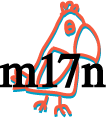Character Property
-
CATEGORY.tab
Unicode general category for each character that is available as Mcategory property.
-
COMBINE.tab
Unicode combining class for each character that is available as Mcombining_class property.
-
BIDI.tab
Unicode BIDI category for each character that is available as Mbidi_category property.
-
CASE-S.tab
Unicode case-folding mapping of each character that is available as Msimple_case_folding property.
-
CASE-C.tab
Unicode complicated case-folding mapping of each character that is available as Mcomplicated_case_folding property.
-
NAME.tab
Unicode character name for each character that is available as Mname property.
-
SCRIPT.tab
Unicode script name for each character that is available as Mscript property.
-
CASED.tab
Unicode properties for case operations. Integer value 1 means cased (D47, Unicode 4.0, p.89), 2 means case-ignorable (D47a, Unicode 4.1.0), and 3 means both. Available as Mcased property.
-
SOFT-DOTTED.tab
Unicode property for case operations. Available as Msoft_dotted property.
-
CASE-MAPPING.tab
Unicode case mapping of each character that is available as Mcase_mapping property.
-
BLOCKS.tab
Unicode fallback script name for each character that is available as Mblock property. Generated manually by referring UCD Blocks.txt.
Input method
See Input Method for the format of these files.
-
am-sera.mim (language:am name:sera icon:
 )
)Amharic input method with SERA. For more information, see the page http://www.geez.org/IM/.
-
ar-kbd.mim (language:ar name:kbd icon:
 )
)Input Method for Arabic simulating Arabic keyboard (MS Windows). The 0-9 keys produce the digits 0-9. Eastern Arabic digits (also called Arabic-Indic digits) can be typed using AltGr: AltGr-1 -> ١ AltGr-2 -> ٢ AltGr-3 -> ٣ AltGr-4 -> ٤ AltGr-5 -> ٥ AltGr-6 -> ٦ AltGr-7 -> ٧ AltGr-8 -> ٨ AltGr-9 -> ٩ AltGr-0 -> ٠
-
ar-translit.mim (language:ar name:translit icon:
 )
)Arabic input method based on Roman transliteration. It uses common transliterations, when several interpretations are possible you can get other variations with a preceding dot. For some letters the commonly used numbers from chat usage are used, these are then preceded by or two dots. Usually the dotted variation also has dots in the written form. If you speak Arabic, use this translit and have motivated suggestions to improve it, please mail me on joop@kiefte.net
-
as-inscript.mim (language:as name:inscript icon:
 )
)Assamese input method for inscript layout. Reference URL - http://tdil.mit.gov.in/isciichart.pdf Key Summary: The differences between Assamese and Bengali alphabets are: The 'ra' of Assamese is different from Bengali 'ra'. The Assamese inscript keyboard layout has included this key in the English keyboard alphabet "j". The letter 'wa' in Assamese can be found out in the alphabet "b" of the English keyboard. The following are the important key combinations for the Assamese keyboard layout: 1. The alphabet 'ৰ' can be obtained by pressing the key 'j' in the English keyboard. 2. The alphabet 'ৱ' can be obtained by pressing the key 'b' in the English keyboard. 3. The alphabet 'ৎ' can be obtained by pressing the key 'z' in the English keyboard. 4. The alphabet 'ঞ' can be obtained by pressing '}' in the Eglish keyboard. 5. The '।' is located in '>', i.e. 'Shift' and '.' together in the English keyboard. 6. The alphabet 'আ' can be typed in two ways: one is to type 'অ' and then 'া' ,i.e. 'D' and then 'e'; other is by typing 'E' alone. 7. The alphabet 'ঃ' is found in '_' key, i.e. 'Shift' and then '-' key in English keyboard. 8. The alphabet 'ঋ' is located in '+', i.e. 'Shift' and then '=' key in English keyboard. 9. The "Rakar" matra is typed as 'd' and then 'j'. 10. The "ref" is typed as 'j' and then 'd' . 11. Special characters 'জ্ঞ', 'ত্ৰ', 'ক্ষ' and 'শ্ৰ' are included respectively at '%', '^', '&' and '*'. 12. The special combinations for 'ref' and 'rakar' are incorporated respectively at '$' and '#' . 13. The character '৺' can be obtained by pressing 'Z', i.e. 'Shift' and 'z'. Some important combinations are as follows: 1. 'tra' : 'ta' + 'halant' + 'ra' (ত্ৰ) (ত) (্) (ৰ) 'l' 'd' 'j' 2. 'khya': 'ka' + 'halant' + 'Sha' (ক্ষ) (ক) (্) (ষ) 'k' 'd' '<' 3. 'kra': 'ka' + 'halant' + 'ra' (ক্ৰ) (ক) (্) (ৰ) 'k' 'd' 'j' 4. 'akta': 'ka' + 'halant' + 'ta' (ক্ত) (ক) (্) (ত) 'k' 'd' 'l' 5. 'kla' : 'ka' + 'halant' + 'la' (ক্ল) (ক) (্) (ল) 'k' 'd' 'n' 6. ''gya' : 'ja' + 'halant' + 'nya' (জ্ঞ) (জ) (্) (ঞ) 'p' 'd' '}' Author: Amitakhya Phukan <aphukan@redhat.com> -
as-inscript2.mim (language:as name:inscript2 icon:
 )
)Assamese input method for enhanced inscript layout. Reference URL - http://ildc.in/Inscript-layout.html Use AltGr (Alt_R key) to type the following characters: Character Key ---------------------------- ZWJ AltGr + 1 ZWNJ AltGr + 2 ₹ AltGr + 4 Key Summary: The differences between Assamese and Bengali alphabets are: The 'ra' of Assamese is different from Bengali 'ra'. The Assamese inscript keyboard layout has included this key in the English keyboard alphabet "j". The letter 'wa' in Assamese can be found out in the alphabet "b" of the English keyboard. The following are the important key combinations for the Assamese keyboard layout: 1. The alphabet 'ৰ' can be obtained by pressing the key 'j' in the English keyboard. 2. The alphabet 'ঞ' can be obtained by pressing '}' in the Eglish keyboard. 3. The '।' is located in '>', i.e. 'Shift' and '.' together in the English keyboard. 4. The alphabet 'আ' can be typed in two ways: one is to type 'অ' and then 'া' ,i.e. 'D' and then 'e'; other is by typing 'E' alone. 5. The alphabet 'ঃ' is found in '_' key, i.e. 'Shift' and then '-' key in English keyboard. 6. The alphabet 'ঋ' is located in '+', i.e. 'Shift' and then '=' key in English keyboard. 7. Special characters 'জ্ঞ', 'ত্ৰ', 'ক্ষ' and 'শ্ৰ' are included respectively at '%', '^', '&' and '*'. 8. The special combinations for 'ref' and 'rakar' are incorporated respectively at '$' and '#' . Some important combinations are as follows: 1. 'tra' : 'ta' + 'halant' + 'ra' (ত্ৰ) (ত) (্) (ৰ) 'l' 'd' 'j' 2. 'khya': 'ka' + 'halant' + 'Sha' (ক্ষ) (ক) (্) (ষ) 'k' 'd' '<' 3. 'kra': 'ka' + 'halant' + 'ra' (ক্ৰ) (ক) (্) (ৰ) 'k' 'd' 'j' 4. 'akta': 'ka' + 'halant' + 'ta' (ক্ত) (ক) (্) (ত) 'k' 'd' 'l' 5. 'kla' : 'ka' + 'halant' + 'la' (ক্ল) (ক) (্) (ল) 'k' 'd' 'n' 6. ''gya' : 'ja' + 'halant' + 'nya' (জ্ঞ) (জ) (্) (ঞ) 'p' 'd' '}' Key summary: Amitakhya Phukan <aphukan@redhat.com> -
as-itrans.mim (language:as name:itrans icon:
 )
)Assamese input method by ITRANS transliteration. For the detail of ITRANS, see the page: <http://www.aczoom.com/itrans/>
-
as-phonetic.mim (language:as name:phonetic icon:
 )
)Assamese input method for phonetic layout. Reference URL - http://www.bengalinux.org/images/probhat_layout.png Key Summary: The differences between Assamese and Bengali alphabets are: The 'ra' of Assamese is different from Bengali 'ra'. The Assamese phonetic keyboard layout has made the change in the Bengali keyboard layout but in the same corresponding key of the English keyboard. There is an additional alphabet 'wa' which is not there in Bengali. The following are the important key combinations for the Assamese Phonetic keyboard layout: 1. The alphabet 'ৰ' can be obtained by pressing the key 'R' in the English keyboard. 2. The alphabet 'ৱ' can be obtained by pressing the key '' in the English keyboard. 3. There are two ways of typing the Assamese 'আ' . One is typing 'A' followed by 'a'. The other is by typing 'v' only. 4. The alphabet 'ঞ' can be obtained by pressing '^' i.e 'Shift' and '6' together in the Eglish keyboard. 5. The '।' is located in '.' in the English keyboard. 6. The '৺' can be obtained by pressing '|', i.e. 'Shift' and ''. Some important combinations are as follows: 1. 'tra' : 'ta' + 'halant' + 'ra' (ত্ৰ) (ত) (্) (ৰ) 'f' '/' 'r' 2. 'khya': 'ka' + 'halant' + 'Sha' (ক্ষ) (ক) (্) (ষ) 'k' '/' 'S' (note the capital S for ষ) 3. 'kra': 'ka' + 'halant' + 'ra' (ক্ৰ) (ক) (্) (ৰ) 'k' '/' 'r' 4. 'akta': 'ka' + 'halant' + 'ta' (ক্ত) (ক) (্) (ত) 'k' '/' 'f' (note that f is for ত) 5. 'kla' : 'ka' + 'halant' + 'la' (ক্ল) (ক) (্) (ল) 'k' '/' 'l' Author: Amitakhya Phukan <aphukan@redhat.com> Key Summary: Amitakhya Phukan <aphukan@redhat.com> -
ath-phonetic (language:ath name:phonetic
 )Input method for Carrier language
)Input method for Carrier language
-
be-kbd (language:be name:kbd
 )Input method for Belarusian by simulating the Belarusian keyboard.
)Input method for Belarusian by simulating the Belarusian keyboard.
-
bla-phonetic (language:bla name:phonetic
 )Input method for Blackfoot language
)Input method for Blackfoot language
-
bn-disha.mim (language:bn name:disha icon:
 )
)Bengali input method based on probhat layout. Visual Based Bengali Keymap Layout created by Sayak Sarkar and proposed by Ankur Group (www.ankur.org.in) as part of Google Summer of Code, 2012. Link to Project Page: http://sayak-sarkar.github.com/Disha/ Link to Proposal: http://www.google-melange.com/gsoc/proposal/review/google/gsoc2012/sayak_sarkar/6001 Key summary: To write "juktakhor" i.e. conjunct characters of consonants please use the "halant" character on the key '/' between the two consonant akshar. E.g. ক্ষ = k+/+S র্কি = r+/+i+k ক্তি = k+/+i+f To write two-part vowels please type the pre-base vowel followed by the consonant further followed by the post-base vowel. E.g. কো = [+k+a Author: Sayak Sarkar <sayak.bugsmith@gmail.com> Mentor: Runa Bhattacharjee <runabh@gmail.com> -
bn-inscript.mim (language:bn name:inscript icon:
 )
)Bengali input method for inscript layout. Inscript (Indian Script) Keyboard overlay in accordance to the standardization recommended by the Department of Electronics, Government of India. Reference Link: http://tdil.mit.gov.in/keyoverlay.htm Also see - http://indlinux.org/wiki/index.php/InscriptLayouts#Bengali Key Summary: To write "juktakhor" i.e. conjunct characters of consonants please use the "halant" character on the key 'd' between the two consonant akshar. E.g. ক্ষ = k+d+< Key summary: Runa Bhattacharjee <runab@redhat.com>
-
bn-inscript2.mim (language:bn name:inscript2 icon:
 )
)Bengali input method for enhanced inscript layout. Reference URL - http://ildc.in/Inscript-layout.html Key summary: Use AltGr (Alt_R key) to type the following characters: Character Key ---------------------------- ZWJ AltGr + 1 ZWNJ AltGr + 2 ₹ AltGr + 4 To write "juktakhor" i.e. conjunct characters of consonants please use the "halant" character on the key 'd' between the two consonant akshar. E.g. ক্ষ = k+d+< Key summary: Runa Bhattacharjee <runab@redhat.com>
-
bn-itrans.mim (language:bn name:itrans icon:
 )
)Bengali input method by ITRANS transliteration. Itrans Bengali Keymap Layout created by Avinash Chopde in accordance with the details in the following link: http://www.aczoom.com/itrans/beng/node4.html Key Summary: The consonant alphabets are represented as half-characters by default i.e. k = ক্ . To complete the character please use 'a' representing 'অ' i.e. ka=ক. Consonant conjuncts can be created by writing the consonant characters in sequential order. To complete the conjunct either 'অ' or any other dependent vowel [অ (a), া(aa), ি(i), ী(ii), ু(u), ূ(uu), ে(e), ৈ(ai), ো (o), ৌ (au)] needs to be added at the end. E.g. ক্রিয়া = k+r+i+Y+A To write 'Khaanda-ta' (ৎ) use the key combination : t.h Detailed instructions for typing are available at the above mentioned link The following keysequences are not defined in the mentioned page, but added for users' sake: Ch JN shh yh dny LLi L^i RRI R^I LLI L^I # $ ^ * ] Shift-SPC Control-SPC
-
bn-national-jatiya.mim (language:bn name:national-jatiya icon:
 )
)Bengali input method for National Jatiya layout. https://en.wikipedia.org/wiki/Bengali_input_methods#Bangla_Jatiyo Layout taken from https://github.com/OpenBangla/OpenBangla-Keyboard/blob/master/data/National_Jatiya.json and ported to m17n-db, merging in differences /usr/share/X11/xkb/symbols/bd as far as possible, giving priority to National_Jatiya.json in case of a conflict. One of the conflicts is that National_Jatiya.json has ZWNJ on ` and AltGr+` and ZWJ on ~ and AltGr+~ whereas /usr/share/X11/xkb/symbols/bd produces the ASCII characters ` and ~ on these keys. See also: https://en.wikipedia.org/wiki/Bengali_input_methods#/media/File:KB-Bengali-Jatiyo.svg The layout picture from Wikipedia shows a few characters on AltGr which do exist neither in National_Jatiya.json nor /usr/share/X11/xkb/symbols/bd. On top of implementing the plain “National Jatiya” keyboard layout, this input method also does “automatic vowel forming”, i.e. if a diacritical form of a vowel like া U+09BE BENGALI VOWEL SIGN AA is typed after a consonant, it is inserted like that but if it is typed anywhere else, not following a consonant, it is inserted as আ U+0986 BENGALI LETTER AA See also: https://github.com/lifeparticle/Bengali-Alphabet/blob/master/vowel_diacritics.md http://unicode.org/charts/nameslist/n_0980.html
-
bn-probhat.mim (language:bn name:probhat icon:
 )
)Bengali input method for probhat layout. Phonetic Based Bengali Keymap Layout created by Taneem Ahmed and proposed by Ankur Group (www.bengalinux.org) in accordance to the image in the following link: http://www.bengalinux.org/images/probhat_layout.png Key summary: To write "juktakhor" i.e. conjunct characters of consonants please use the "halant" character on the key '/' between the two consonant akshar. E.g. ক্ষ = k+/+S Author: Jatin Nansi <jnansi@redhat.com> Key summary: Runa Bhattacharjee <runab@redhat.com>
-
bn-unijoy.mim (language:bn name:unijoy icon:
 )
)Bengali input method simulating Unijoy keyboard layout. <http://ekushey.org/?page/uni_joy_layout>
-
bo-ewts.mim (language:bo name:ewts icon:
 )
)Tibetan input method based on EWTS. This implementation is based on THDL Extended Wylie Transliteration Scheme Version 2.0 <http://www.thlib.org/reference/transliteration/#!essay=/thl/ewts>.
-
bo-tcrc.mim (language:bo name:tcrc icon:
 )
)Tibetan input method using the TCRC keyboard layout. For more information, see the page: http://www.tibet.net/tb/download/tcrckbd.rtf
-
bo-wylie.mim (language:bo name:wylie icon:
 )
)Tibetan input method based on the Wylie transliteration. It is actually the re-implementation of Emacs' tibetan-wylie input method, and is slightly different from Extended Wylie Transliteration Scheme (EWTS). The exact EWTS-based input method is in bo-ewts.mim.
-
brx-inscript2-deva.mim (language:brx name:inscript2-deva icon:
 )
)Bodo input method for enhanced inscript layout. Reference URL - http://ildc.in/Inscript-layout.html Use AltGr (Alt_R key) to type the following characters: Character Key ---------------------------- ZWJ AltGr + 1 ZWNJ AltGr + 2 ₹ AltGr + 4
-
cjk-util.mim (extra-name:nil, only for inclusion)
Provide utilities for CJK input methods. This is acutually not a standalone input method, but is expected to be included in the other input method (e.g. zh-py). The fullwidth mode is turned on by typing ">>", and turned off by typing "<<". The single fullwidth mode is turned on by typing "Z". In this mode, any key typed is converted to the fullwidth character and is inserted, then the mode is turned off.
-
cmc-kbd.mim (language:cmc name:kbd icon:
 )
)Cham input method simulating Cham keyboard. Cham characters are encoded in logical order in memory and in files. But, you can type Cham text in visual order with this input method. Backspace and Delete also work in the manner of visual order.
-
cr-western (language:cr name:western
 )Input method for Western Cree dialects
)Input method for Western Cree dialects
-
cs-kbd (language:cs name:kbd
 )Input method for Czech simulating the standard Czech keyboard.
)Input method for Czech simulating the standard Czech keyboard.
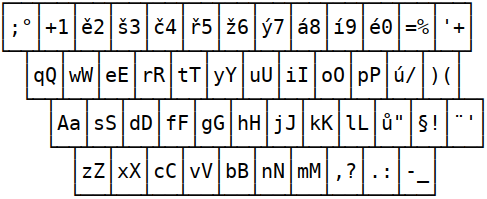 Keyboard Layout
Keyboard LayoutYou can also input more characters by the following key sequences:

-
da-post.mim (language:da name:post icon:
 )
)Danish input method with postfix modifiers.
-
doi-inscript2-deva.mim (language:doi name:inscript2-deva icon:
 )
)Dogri input method for enhanced inscript layout. Reference URL - http://ildc.in/Inscript-layout.html Use AltGr (Alt_R key) to type the following characters: Character Key ---------------------------- ZWJ AltGr + 1 ZWNJ AltGr + 2 ₹ AltGr + 4
-
dra-iso-15919-itrans.mim (language:dra name:iso-15919-itrans icon:
 )
)Dravidian ISO-15919 input method roughly mapped from ITRANS and Harvard-Kyoto transliteration systems. Such a mapping is particularly useful for people who use ITRANS / Harvard-Kyoto based input methods (found for example in sa-itrans.mim) to type sanskrit in other scripts. Not having to memorize multiple input maps for multiple scripts is a plus. You can use all the standard ITRANS key sequences (other than ch, which has a different meaning in this script) plus key sequences such as the below. nk->ṅk, nkh->ṅkh, ng->ṅg, ngh->ṅgh nc->ñc, nch->ñch, nj->ñj, njh->ñjh, nT->ṇṭ, nTh->ṇṭh, nD->ṇḍ, nDh->ṇḍh S->ṣ, jn->jñ, R->r̥ Unlike classical Sanskrit, e and o are not automatically mapped to ē and ō. So, this also serves to type via reconstructed vedic pronunciation sanskrit, where ai=ए, Ai=ऐ, au=ओ, Au=औ. Capital letters may be produced or forced by prefixing a ~, reduplicating a letter (T,D,N,R) for disambiguation where necessary. For example: Raama or ~Raama -> Rāma, ~RRkaara -> R̥kāra, KRShNa or ~KRShNa -> Kr̥ṣṇa, ~Tyaaga -> Tyāga, ~TTakaara -> Ṭakāra, ~Dhiira -> Dhīra, ~DDhakaara -> Ḍhakāra, ~LLakaara -> Ḷakāra The motivation behind additions made to the basic ITRANS scheme is described in https://sanskrit-coders.github.io/input/optitrans/, along with a tabulated comparison with several other transliteration schemes. Also, see: http://en.wikipedia.org/wiki/Devanagari_transliteration.
-
dv-phonetic.mim (language:dv name:phonetic icon:
 )
)Dhivehi input method simulating the Dhivehi phonetic keyboard. The layout is approved by the Molvidian Ministry of Communication, Science and Technology. <http://www.mcst.gov.mv/News_and_Events/xpfonts.htm>
-
el-kbd (language:el name:kbd
 )Input method for Greek simulating Greek keyboard.
)Input method for Greek simulating Greek keyboard.
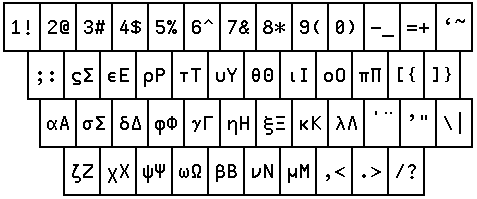 Keyboard Layout
Keyboard Layout -
eo-h-fundamente (language:eo name:h-fundamente
 )Copyright (C) 2007 Joop Kiefte (LaPingvino)
)Copyright (C) 2007 Joop Kiefte (LaPingvino)
This file is part of the m17n contrib; a sub-part of the m17n
library.
The m17n library is free software; you can redistribute it and/or
modify it under the terms of the GNU Lesser General Public License
as published by the Free Software Foundation; either version 2.1 of
the License, or (at your option) any later version.
The m17n library is distributed in the hope that it will be useful,
but WITHOUT ANY WARRANTY; without even the implied warranty of
MERCHANTABILITY or FITNESS FOR A PARTICULAR PURPOSE. See the GNU
Lesser General Public License for more details.
You should have received a copy of the GNU Lesser General Public
License along with the m17n library; if not, write to the Free
Software Foundation, Inc., 51 Franklin Street, Fifth Floor,
Boston, MA 02110-1301, USA.
- eo-h-f.mim
Inputmethod for Esperanto // Enigmetodo por Esperanto
- eo-h-f.mim
-
eo-h-sistemo (language:eo name:h-sistemo
 )Copyright (C) 2007 Joop Kiefte (LaPingvino)
)Copyright (C) 2007 Joop Kiefte (LaPingvino)
This file is part of the m17n contrib; a sub-part of the m17n
library.
The m17n library is free software; you can redistribute it and/or
modify it under the terms of the GNU Lesser General Public License
as published by the Free Software Foundation; either version 2.1 of
the License, or (at your option) any later version.
The m17n library is distributed in the hope that it will be useful,
but WITHOUT ANY WARRANTY; without even the implied warranty of
MERCHANTABILITY or FITNESS FOR A PARTICULAR PURPOSE. See the GNU
Lesser General Public License for more details.
You should have received a copy of the GNU Lesser General Public
License along with the m17n library; if not, write to the Free
Software Foundation, Inc., 51 Franklin Street, Fifth Floor,
Boston, MA 02110-1301, USA.
- eo-h.mim
Inputmethod for Esperanto // Enigmetodo por Esperanto
- eo-h.mim
-
eo-plena (language:eo name:plena
 )Copyright (C) 2007 Joop Kiefte (LaPingvino)
)Copyright (C) 2007 Joop Kiefte (LaPingvino)
This file is part of the m17n contrib; a sub-part of the m17n
library.
The m17n library is free software; you can redistribute it and/or
modify it under the terms of the GNU Lesser General Public License
as published by the Free Software Foundation; either version 2.1 of
the License, or (at your option) any later version.
The m17n library is distributed in the hope that it will be useful,
but WITHOUT ANY WARRANTY; without even the implied warranty of
MERCHANTABILITY or FITNESS FOR A PARTICULAR PURPOSE. See the GNU
Lesser General Public License for more details.
You should have received a copy of the GNU Lesser General Public
License along with the m17n library; if not, write to the Free
Software Foundation, Inc., 51 Franklin Street, Fifth Floor,
Boston, MA 02110-1301, USA.
- eo-plena.mim
Inputmethod for Esperanto // Enigmetodo por Esperanto
- eo-plena.mim
-
eo-q-sistemo (language:eo name:q-sistemo
 )Copyright (C) 2007 Joop Kiefte (LaPingvino)
)Copyright (C) 2007 Joop Kiefte (LaPingvino)
This file is part of the m17n contrib; a sub-part of the m17n
library.
The m17n library is free software; you can redistribute it and/or
modify it under the terms of the GNU Lesser General Public License
as published by the Free Software Foundation; either version 2.1 of
the License, or (at your option) any later version.
The m17n library is distributed in the hope that it will be useful,
but WITHOUT ANY WARRANTY; without even the implied warranty of
MERCHANTABILITY or FITNESS FOR A PARTICULAR PURPOSE. See the GNU
Lesser General Public License for more details.
You should have received a copy of the GNU Lesser General Public
License along with the m17n library; if not, write to the Free
Software Foundation, Inc., 51 Franklin Street, Fifth Floor,
Boston, MA 02110-1301, USA.
- eo-q.mim
Inputmethod for Esperanto // Enigmetodo por Esperanto
- eo-q.mim
-
eo-vi-sistemo (language:eo name:vi-sistemo
 )Created by: Trần Ngọc Quân
)Created by: Trần Ngọc Quân
Email: vnwil.nosp@m.dman.nosp@m.@gmai.nosp@m.l.co.nosp@m.m
Started: 2009-02-19
Last modified: 2009-08-30
This file is part of the m17n contrib; a sub-part of the m17n
library.
The m17n library is free software; you can redistribute it and/or
modify it under the terms of the GNU Lesser General Public License
as published by the Free Software Foundation; either version 2.1 of
the License, or (at your option) any later version.
The m17n library is distributed in the hope that it will be useful,
but WITHOUT ANY WARRANTY; without even the implied warranty of
MERCHANTABILITY or FITNESS FOR A PARTICULAR PURPOSE. See the GNU
Lesser General Public License for more details.
You should have received a copy of the GNU Lesser General Public
License along with the m17n library; if not, write to the Free
Software Foundation, Inc., 51 Franklin Street, Fifth Floor,
Boston, MA 02110-1301, USA.
- eo-vi-sistemo.mim
Inputmethod for Esperanto // Enigmetodo por Esperanto
- eo-vi-sistemo.mim
-
eo-x-sistemo (language:eo name:x-sistemo
 )Copyright (C) 2007 Joop Kiefte (LaPingvino)
)Copyright (C) 2007 Joop Kiefte (LaPingvino)
This file is part of the m17n contrib; a sub-part of the m17n
library.
The m17n library is free software; you can redistribute it and/or
modify it under the terms of the GNU Lesser General Public License
as published by the Free Software Foundation; either version 2.1 of
the License, or (at your option) any later version.
The m17n library is distributed in the hope that it will be useful,
but WITHOUT ANY WARRANTY; without even the implied warranty of
MERCHANTABILITY or FITNESS FOR A PARTICULAR PURPOSE. See the GNU
Lesser General Public License for more details.
You should have received a copy of the GNU Lesser General Public
License along with the m17n library; if not, write to the Free
Software Foundation, Inc., 51 Franklin Street, Fifth Floor,
Boston, MA 02110-1301, USA.
eo-x.mim
Inputmethod for Esperanto // Enigmetodo por Esperanto
-
fa-isiri.mim (language:fa name:isiri icon:
 )
)Farsi input method simulating ISIRI 2901-1994 keyboard layout. This is for typing Farsi by Arabic characters.
-
fr-azerty.mim (language:fr name:azerty icon:
 )
)Simulating Azerty keyboard on English keyboard. &1 é2 "3 '4 (5 -6 è7 _8 ç9 à0 )° =_ ²~ aA zZ eE rR tT yY uU iI oO pP ^¨ $£ qQ sS dD fF gG hH jJ kK lL mM ù% *| wW xX cC vV bB nN ,? ;. :/ !§ '[' and '{' are used as a dead key to type a character with the circumflex and diaeresis respectively (e.g. '[' 'e' -> "ê"). 'Alt-2' and 'Alt-7' are used as a dead key to type a character with tilde and grave respectively (e.g. 'Alt-2' 'n' -> "ñ"). 'Ctrl-Alt-2' and 'Ctrl-Alt-7' can be used as 'Alt-2' and 'Alt-7' respectively. Azerty keyboard has one more key at the bottom left corner for inputting "<" and ">". As a normal English keyboard doesn't have such a key left, type '<' and '>' twice for "<" and ">" respectively. -
global.mim (extra-name:nil, only for inclusion)
グローバル変数及びグローバルコマンドの定義 これ自体は入力メソッドではなく、グローバル変数の説明と値、 グローバルコマンドの説明とキーバインドを提供するもの。
-
grc-mizuochi.mim (language:grc name:mizuochi icon:
 )
)Mizuochi input method for classical Greek. ------------------------------------- character capital small ------------------------------------- alpha A a beta B b gamma G g delta D d epsilon E e zeta Z z eta H h theta Q q iota I i kappa K k lamda L l mu M m nu H n xi X x omicron O o pi P p rho R r sigma S s final sigma j tau T t upsilon U u phi F f chi C c psi Y y omega W w ------------------------------------- sampi ! digamma # stigma $ koppa & % ------------------------------------- ------------------------ mark key ------------------------ ypogegrammeni J psili ' or v dasia ` or V oxia / varia ? perispomeni \ or ^ dialytika " ano teleia : erotimatiko ; ----------------------
-
gu-inscript.mim (language:gu name:inscript icon:
 )
)Gujarati input method for inscript layout. Reference URL - http://indlinux.org/wiki/index.php/InscriptLayouts#Gujarati Key summary :- 1. જ્ઞ : % This can also be typed as a sequence of following: જ + ્ + ઞ i.e. p + d + } 2. ત્ર : ^ This can also be typed as a sequence of following: ત + ્ + ર i.e. l + d + j 3. ક્ષ : & This can also be typed as a sequence of following: ક + ્ + ષ i.e. k + d + < 4. શ્ર : * This can also be typed as a sequence of following: શ + ્ + ર i.e. M + d + j Key summary: Ankitkumar Rameshchandra Patel <ankit@redhat.com> -
gu-inscript2.mim (language:gu name:inscript2 icon:
 )
)Gujarati input method for enhanced inscript layout. Reference URL - http://ildc.in/Inscript-layout.html Use AltGr (Alt_R key) to type the following characters: Character Key ---------------------------- ZWJ AltGr + 1 ZWNJ AltGr + 2 ₹ AltGr + 4
-
gu-itrans.mim (language:gu name:itrans icon:
 )
)Gujarati input method by ITRANS transliteration. For the detail of ITRANS, see the page: <http://www.aczoom.com/itrans/>
-
gu-phonetic.mim (language:gu name:phonetic icon:
 )
)Gujarati input method for phonetic layout. Key Summary: 1. ત્ર : ^ This can also be typed as a sequence of following: ત + ્ + ર i.e. t + f + r 2. ક્ષ : X This can also be typed as a sequence of following: ક + ્ + ષ i.e. k + f + x 3. શ્ર : * This can also be typed as a sequence of following: શ + ્ + ર i.e. S + f + r Author: Jatin Nansi <jnansi@redhat.com> Key Summary: Ankitkumar Rameshchandra Patel <ankit@redhat.com> -
he-kbd (language:he name:kbd
 )Input method for Hebrew simulating Hebrew keyboard.
)Input method for Hebrew simulating Hebrew keyboard.
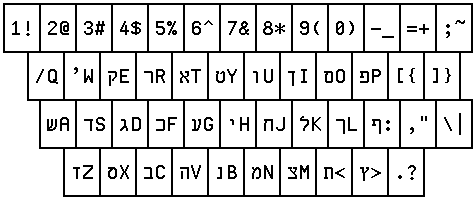 Keyboard Layout
Keyboard Layout -
hi-brahmi-itrans.mim (language:hi name:brahmi-itrans icon:
 )
)Hindi brAhmi input method by ITRANS and Harvard-Kyoto transliteration systems. You can use all the standard ITRANS key sequences plus key sequences such as the below. nk->𑀗𑁆𑀓𑁆, nkh->𑀗𑁆𑀔𑁆, ng->𑀗𑁆𑀕𑁆, ngh->𑀗𑁆𑀖𑁆 nch->𑀜𑁆𑀘𑁆, nCh->𑀜𑁆𑀙𑁆, nc->𑀜𑁆𑀘𑁆, nC->𑀜𑁆𑀙𑁆, nchh->𑀜𑁆𑀙𑁆, nj->𑀜𑁆𑀚𑁆, njh->𑀜𑁆𑀛𑁆, nT->𑀡𑁆𑀝𑁆, nTh->𑀡𑁆𑀞𑁆, nD->𑀡𑁆𑀟𑁆, nDh->𑀡𑁆𑀠𑁆 c->𑀘𑁆, C->𑀙𑁆, z->𑀰𑁆, S->𑀱𑁆, jn->𑀚𑁆𑀜𑁆, R->𑀋 In addition, for convenience, when a consonant + halant sequence is followed by non Devanagari letter, the last halant is removed. For instance, 'k SPC'->'𑀓 ', 'k..'->'𑀓𑁇'. The motivation behind additions made to the basic ITRANS scheme is described in https://sanskrit-coders.github.io/input/optitrans/, along with a tabulated comparison with several other transliteration schemes. Also, see: http://en.wikipedia.org/wiki/Devanagari_transliteration.
-
hi-inscript.mim (language:hi name:inscript icon:
 )
)Hindi input method for inscript layout. Reference URL : http://indlinux.org/wiki/index.php/InscriptLayouts#Devanagari Key Summary: 1. ज्ञ : % This can also be typed as a sequence of following: ज + ् + ञ i.e. p + d + } 2. त्र : ^ This can also be typed as a sequence of following: त + ् + र i.e. l + d + j 3. क्ष : & This can also be typed as a sequence of following: क + ् + ष i.e. k + d + < 4. श्र : * This can also be typed as a sequence of following: श + ् + र i.e. M + d + j Key summary: Rajesh Ranjan <rranjan@redhat.com> -
hi-inscript2.mim (language:hi name:inscript2 icon:
 )
)Hindi input method for enhanced inscript layout. Reference URL : http://ildc.in/Inscript-layout.html Use AltGr (Alt_R key) to type the following characters: Character Key ---------------------------- ZWJ AltGr + 1 ZWNJ AltGr + 2 ₹ AltGr + 4
-
hi-itrans.mim (language:hi name:itrans icon:
 )
)Hindi input method by ITRANS and Harvard-Kyoto transliteration systems. You can use all the standard ITRANS key sequences plus key sequences such as the below. nk->ङ्क्, nkh->ङ्ख्, ng->ङ्ग्, ngh->ङ्घ् nch->ञ्च्, nCh->ञ्छ्, nc->ञ्च्, nC->ञ्छ्, nchh->ञ्छ्, nj->ञ्ज्, njh->ञ्झ्, nT->ण्ट्, nTh->ण्ठ्, nD->ण्ड्, nDh->ण्ढ् c->च्, C->छ्, z->श्, S->ष्, jn->ज्ञ्, R->ऋ In addition, for convenience, when a consonant + halant sequence is followed by non Devanagari letter, the last halant is removed. For instance, 'k SPC'->'क ', 'k..'->'क।'. The motivation behind additions made to the basic ITRANS scheme is described in https://sanskrit-coders.github.io/input/optitrans/, along with a tabulated comparison with several other transliteration schemes. Also, see: http://en.wikipedia.org/wiki/Devanagari_transliteration.
-
hi-optitransv2.mim (language:hi name:optitransv2 icon:
 )
)Hindi input method by the OPTITRANS transliteration system. 0. A major deviation from other transliteration systems like ITRANS and HK is that latin consonants are mapped to the correpsonding devanAgarI consonant *followed by the vowel a*. For example, k maps to क, not क्. 1. panchama-varNa-s of vyanjana-varga-s nnk->ङ्क, nnkh->ङ्ख, nng->ङ्ग, nngh->ङ्घ nnch->ञ्च, nnCh->ञ्छ, nnc->ञ्च, nnC->ञ्छ, 2. Any common consonant, typed twice, yields that consonant with the virAma. So, nn yields न्. The rationale is that a repeated consonant such as नन and दद is far less common than the consonants with a virAma, such as न् and द्. 3. The rare character sequences that conflict with shortcuts for more frequently occuring strings can be typed using the
-
hi-phonetic.mim (language:hi name:phonetic icon:
 )
)Hindi input method for phonetic layout. Key Summary: 1. ज्ञ : ^ This can also be typed as a sequence of following: ज + ् + ञ i.e. j +f + % 2. त्र : not available here shd be one This can also be typed as a sequence of following: त + ् + र i.e. t + f + r 3. क्ष : X This can also be typed as a sequence of following: क + ् + ष i.e. k + f + x 4. श्र : * This can also be typed as a sequence of following: श + ् + र i.e. S + f + r Author: Jatin Nansi <jnansi@redhat.com> Key summary: Rajesh Ranjan <rranjan@redhat.com> -
hi-remington.mim (language:hi name:remington icon:
 )
)Hindi input method for Remington typewriter layout. Author: Rajesh Ranjan <rranjan@redhat.com>
-
hi-typewriter.mim (language:hi name:typewriter icon:
 )
)Hindi input method with `typewriter' method. Still experimental.
-
hi-vedmata.mim (language:hi name:vedmata icon:
 )
)Hindi input method for Remington typewriter layout. Author: Shantikunj, Haridwar, UK, INDIA <www.awgp.org>
-
hr-kbd (language:hr name:kbd
 )Input method for Croatian.
)Input method for Croatian.
Simulating Croatian Latin keyboard on American keyboard.
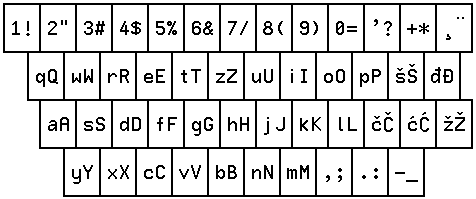 Keyboard Layout
Keyboard Layout -
hu-rovas-post.mim (language:hu name:rovas-post icon:
 )
)Input method for the Old Hungarian script Can be used on any keyboard layout which supports ASCII. The accented modern Hungarian characters are typed in the same way as in the latn-post.mim input method (o' -> ó, o" -> ö, o: -> ő etc. ..). For details see the table below. This table follows the information in the Wikipedia page https://en.wikipedia.org/wiki/Old_Hungarian_alphabet Latin letter(s) | Input sequence | Old Hungarian ================================================ a a 𐳀 A A 𐲀 á a' 𐳁 Á A' 𐲁 b b 𐳂 B B 𐲂 c c 𐳄 C C 𐲄 cs cs 𐳆 Cs Cs 𐲆 CS CS 𐲆 d d 𐳇 D D 𐲇 dz dz 𐳇𐳯 ¹ Dz Dz 𐲇𐲯 ¹ DZ DZ 𐲇𐲯 ¹ dzs dzs 𐳇𐳰 ¹ Dzs Dzs 𐲇𐲰 ¹ DZs DZs 𐲇𐲰 ¹ DZS DZS 𐲇𐲰 ¹ e e 𐳉 E E 𐲉 ë e" 𐳊 Ë E" 𐲊 é e' 𐳋 É E' 𐲋 f f 𐳌 F F 𐲌 g g 𐳍 G G 𐲍 gy gy 𐳎 Gy Gy 𐲎 GY GY 𐲎 h h 𐳏 H H 𐲏 i i 𐳐 I I 𐲐 í i' 𐳑 Í I' 𐲑 j j 𐳒 J J 𐲒 k k 𐳓 K K 𐲓 k AltGr-k 𐳔 K AltGr-K 𐲔 l l 𐳖 L L 𐲖 ly ly 𐳗 Ly Ly 𐲗 LY LY 𐲗 m m 𐳘 M M 𐲘 n n 𐳙 N N 𐲙 ny ny 𐳚 Ny Ny 𐲚 NY NY 𐲚 o o 𐳛 O O 𐲛 ó o' 𐳜 Ó O' 𐲜 ö o" 𐳞 Ö O" 𐲞 ö AltGr-o 𐳝 Ö AltGr-O 𐲝 ő o: 𐳟 Ő O: 𐲟 p p 𐳠 P P 𐲠 q q 𐳓𐳮 ¹ Q Q 𐲓𐲮 ¹ r r 𐳢 R R 𐲢 s s 𐳤 S S 𐲤 sz sz 𐳥 Sz Sz 𐲥 SZ SZ 𐲥 t t 𐳦 T T 𐲦 ty ty 𐳨 Ty Ty 𐲨 TY TY 𐲨 u u 𐳪 U U 𐲪 ú u' 𐳫 Ú U' 𐲫 ü u" 𐳬 Ü U" 𐲬 ű u: 𐳭 Ű U: 𐲭 v v 𐳮 V V 𐲮 w w 𐳮𐳮 ¹ W W 𐲮𐲮 ¹ x x 𐳓𐳥 ¹ X X 𐲓𐲥 ¹ y y 𐳐𐳒 ¹ Y Y 𐲐𐲒 ¹ z z 𐳯 Z Z 𐲯 zs zs 𐳰 Zs Zs 𐲰 ZS ZS 𐲰 ENT ENT 𐲧 ³ EMP EMP 𐲡 ³ UNK UNK 𐲕 ³ US US 𐲲 ³ AMB AMB 𐲃 ³ Footnotes: ¹ With a supporting font, this will be displayed as a ligature. ² Repeating the postfix changes ambiguous combining marks: Example: u -> 𐳪, u' -> 𐳫, u'' -> 𐳪', u''' -> 𐳫' ³ The Hungarian runes also include some non-alphabetical runes which are not ligatures but separate signs. These are called capita dictionum.
-
hy-kbd (language:hy name:kbd
 )Input method for Armenian.
)Input method for Armenian.
Simulating Eastern Armenian keyboard on American keyboard.
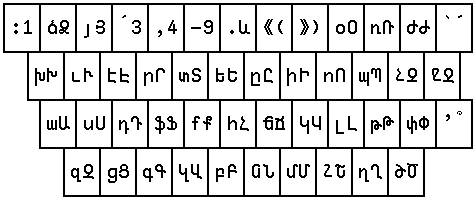 Keyboard Layout
Keyboard Layout -
ii-phonetic (language:ii name:phonetic
 )Input method for Yi
)Input method for Yi
;;;;;;;;
;;
;;
;;;
;;;
;;
;;
;;
;;;;
;;
;;
;;;;
;;
;;
;;
;;;
;
;;;;;
;;;;
;;;;;;;;
;;;;
;;;;;;;;;;
;;;;;;;;;;
;;;;
;;;;;;
;;;;;
;;;;;;;;
;;;;;;;
;;;;;;;;
;;;;
;;;;;;;;;;;;;;;;;;;
;;;;;
;;;
;;
;;;;;;
;;;;;;;;;;;
Radicals
;;;;;;;;;;;
-
ispell.mim (language:en name:ispell)
Not yet officially released.
-
iu-phonetic (language:iu name:phonetic
 )Input method for Inuktitut
)Input method for Inuktitut
-
ja-anthy.mim (language:ja name:anthy icon:
 )
)Japanese input method with Anthy as a kana-kanji converter. Typed roma-ji is at first converted to Hiragana, and Space key converts the Hiragana sequences to Kanji-Hiragana mixed sequence. This input method uses the loadable module libmimx-anthy.so to communicate with Anthy. For more detail about Anthy, see the page <http://sourceforge.jp/projects/anthy/>.
-
ja-tcode.mim (language:ja name:tcode icon:
 )
)Input method for Japanese with TCODE.
-
ja-trycode.mim (language:ja name:trycode icon:
 )
)Input method for Japanese with TRY-CODE. See <http://www.m17n.org/ntakahas/npx/aggressive/aggressive4.en.html> for the details.
-
ka-kbd (language:ka name:kbd
 )Input method for Georgian simulating Georgian keyboard.
)Input method for Georgian simulating Georgian keyboard.
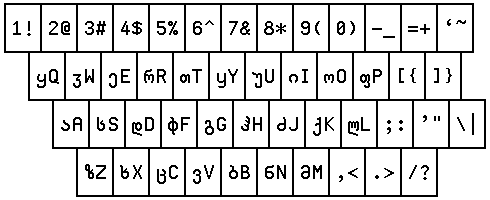 Keyboard Layout
Keyboard LayoutYou can also input more characters by the following key sequences:
[type a key sequence to insert the corresponding character]

-
kk-arabic.mim (language:kk name:arabic icon:
 )
)Kazakh (with Arabic script) input method by transliteration. 1 2 3 4 5 6 7 8 9 10 11 12 13 14 15 16 17 a A b v g R d e j z y k q l m n N 18 19 20 21 22 23 24 25 26 27 28 29 30 31 32 33 o O p r s t w u U f H h c S I i
-
kk-kbd (language:kk name:kbd
 )Input method for Kazakh written in the Cyrillic script.
)Input method for Kazakh written in the Cyrillic script.
Simulating Kazakh keyboard.
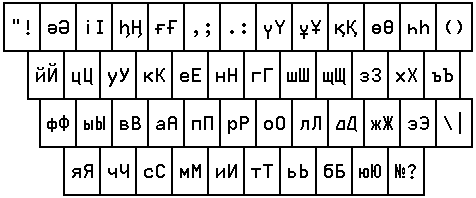 Keyboard Layout
Keyboard Layout -
km-yannis.mim (language:km name:yannis icon:
 )
)Khmer input method suggested by Dr. Yannis Haralambous.
-
kn-inscript.mim (language:kn name:inscript icon:
 )
)Kannada input method for inscript layout. Key summary : 1) "praa" = pa + halant + raa "ಪ್ರಾ" = ಪ + ್ + ರ + ಾ h + d + j + e 2) "ska" = sa+halant+ka "ಸ್ಕ" = ಸ + ್ + ಕ m + d + k 3) "ththhaa" = th + halanth + thhaa " ತ್ಥಾ" = ತ + ್ +ಥ + ಾ l + d + L + e 4) "shhtya" : shh + halat + T + halant + ya "ಷ್ಟ್ಯ" = ಷ +್ + ಟ + ್ + ಯ < + d + ' + d + / 5) "dgaa" : d + halant + gaa "ದ್ಗಾ" : ದ + ್ + ಗ +ಾ o + d + i + e 6) "ksha" : k + halant + sha "ಕ್ಷ" : ಕ + ್ + ಷ k + d + < [OR] & 7) "thra": th + halant + r + a "ತ್ರ" : ತ + ್ +ರ l + d + j [OR] ^ 8) "jna" : j + halant + na "ಜ್ಞ" : ಜ + ್ + ಞ p + d + } [OR] % 9) ZWNJ is assigned to key 'V' ZWJ is assigned to key '\\' Key summary: Shankar Prasad <svenkate@redhat.com> -
kn-inscript2.mim (language:kn name:inscript2 icon:
 )
)Kannada input method for enhanced inscript layout. Reference URL - http://ildc.in/Inscript-layout.html Use AltGr (Alt_R key) to type the following characters: Character Key ---------------------------- ZWJ AltGr + 1 ZWNJ AltGr + 2 ₹ AltGr + 4 Key summary : 1) "praa" = pa + halant + raa "ಪ್ರಾ" = ಪ + ್ + ರ + ಾ h + d + j + e 2) "ska" = sa+halant+ka "ಸ್ಕ" = ಸ + ್ + ಕ m + d + k 3) "ththhaa" = th + halanth + thhaa " ತ್ಥಾ" = ತ + ್ +ಥ + ಾ l + d + L + e 4) "shhtya" : shh + halat + T + halant + ya "ಷ್ಟ್ಯ" = ಷ +್ + ಟ + ್ + ಯ < + d + ' + d + / 5) "dgaa" : d + halant + gaa "ದ್ಗಾ" : ದ + ್ + ಗ +ಾ o + d + i + e 6) ZWJ is assigned to key 'AltGr+1' ZWNJ is assigned to key 'AltGr+2' Key summary: Shankar Prasad <svenkate@redhat.com> -
kn-itrans.mim (language:kn name:itrans icon:
 )
)Kannada input method by ITRANS, Baraha and Harvard-Kyoto transliteration systems. You can use all the standard ITRANS key sequences plus key sequences such as the below. nk->ಂಕ್, nkh->ಂಖ್, ng->ಂಗ್, ngh->ಂಘ್ nch->ಂಚ್, nCh->ಂಛ್, nc->ಂಚ್, nC->ಂಛ್, nchh->ಂಛ್, nj->ಂಜ್, njh->ಂಝ್, nT->ಂಟ್, nTh->ಂಠ್, nD->ಂಡ್, nDh->ಂಢ್ c->ಚ್, C->ಛ್, z->ಶ್, S->ಷ್, jn->ಜ್ಞ್, R->ಋ The motivation behind additions made to the basic ITRANS scheme is described in https://sanskrit-coders.github.io/input/optitrans/, along with a tabulated comparison with several other transliteration schemes. Earlier changes: Kannada l10n Team, kannada.l10n@gmail.com <http://kannada.sourceforge.net> on 18 Aug 2005.
-
kn-kgp.mim (language:kn name:kgp icon:
 )
)Kannada input method by KGP method.
-
kn-optitransv2.mim (language:kn name:optitransv2 icon:
 )
)Kannada input method by the OPTITRANS transliteration system. 0. A major deviation from other transliteration systems like ITRANS and HK is that latin consonants are mapped to the correpsonding devanAgarI consonant *followed by the vowel a*. For example, k maps to ಕ, not ಕ್. 1. panchama-varNa-s of vyanjana-varga-s nnk->ಙ್ಕ, nnkh->ಙ್ಖ, nng->ಙ್ಗ, nngh->ಙ್ಘ nnch->ಞ್ಚ, nnCh->ಞ್ಛ, nnc->ಞ್ಚ, nnC->ಞ್ಛ, 2. Any common consonant, typed twice, yields that consonant with the virAma. So, nn yields ನ್. The rationale is that a repeated consonant such as ನನ and ದದ is far less common than the consonants with a virAma, such as ನ್ and ದ್. 3. The rare character sequences that conflict with shortcuts for more frequently occuring strings can be typed using the
-
kn-typewriter.mim (language:kn name:typewriter icon:
 )
)Kannada input method for typewriter layout developed by Red Hat and NIC Bengaluru
-
ko-han2 (language:ko name:han2
 )Hangul input method with 2벌식.
)Hangul input method with 2벌식.
This input method uses this keyboard layout:
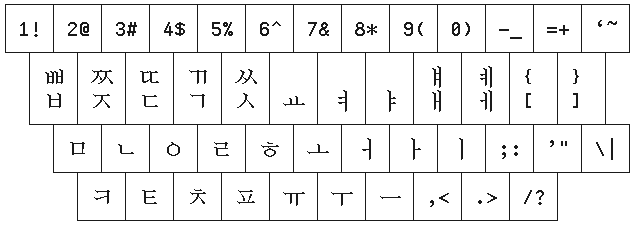 Keyboard Layout
Keyboard Layout -
ko-romaja.mim (language:ko name:romaja icon:
 )
)Hangul input method with romaja keys. The roman-transliteration rules follows that of Hangule LE in IIIMF. Common to CHOSEONG and JONGSEONG: ㄱ(g) ㄲ(gg,kk,qq,c) ㄴ(n) ㄷ(d) ㄹ(l) ㄹ(r) ㅁ(m) ㅂ(b,v) ㅅ(s) ㅆ(ss) ㅇ(ng) ㅇ(x) ㅈ(j) ㅊ(ch) ㅋ(k,q) ㅌ(t) ㅍ(p,f) ㅎ(h) CHOSEONG: ㄸ(dd,tt) ㅃ(bb,vv) ㅉ(jj) JONGSEONG: ㄳ(gs) ㄵ(nj) ㄶ(nh) ㄺ(lg) ㄻ(lm) ㄼ(lb) ㄽ(ls) ㄾ(lt) ㄿ(lp) ㅀ(lh) ㅄ(bs) JUNGSEONG: ㅏ(a) ㅐ(ai,ae) ㅑ (ya,ia) ㅒ(yai,yae,iae) ㅓ(eo) ㅔ(e,eoi) ㅕ(yeo,ieo) ㅖ(ye,ie,yeoi) ㅗ(o) ㅘ(oa,wa,ua) ㅙ(oai,wae,uae,oae) ㅚ(oi,woe,uoe,oe) ㅛ(yo,io) ㅜ(u,w,oo) ㅝ(ueo,wo,uo) ㅞ(ue,we) ㅟ(wi) ㅠ(yu,iu) ㅡ(eu) ㅢ(eui,ui) ㅣ(i,y,ee) Special: Type uppercase letter to specify CHOSEONG explicitly. Type "I" to toggle the composed-syllable mode and isolated-jamo mode. Type ">>" to fullwidth ASCII letter mode, "<<" to shift out the mode. Type "Z" and a key to input fullwidth version of the key.
-
kok-inscript2-deva.mim (language:kok name:inscript2-deva icon:
 )
)Konkani input method for enhanced inscript layout. Reference URL - http://ildc.in/Inscript-layout.html Use AltGr (Alt_R key) to type the following characters: Character Key ---------------------------- ZWJ AltGr + 1 ZWNJ AltGr + 2 ₹ AltGr + 4
-
ks-inscript.mim (language:ks name:inscript icon:
 )
)Kashmiri Devanagari input method for inscript layout. Reference URL : http://indlinux.org/wiki/index.php/InscriptLayouts#Devanagari Key Summary: AltGr (Right Alt Key) ॖDEVANAGARI VOWEL SIGN UE :- Type with [AltGr + 'g'] ॗ DEVANAGARI VOWEL SIGN UUE :- Type with [AltGr + 't'] ॳ DEVANAGARI LETTER OE :- Type with [AltGr + 'Z'] ॴ DEVANAGARI LETTER OOE :- Type with [AltGr + 'A'] ॵ DEVANAGARI LETTER AW :- Type with [AltGr + 'Q'] ॶ DEVANAGARI LETTER UE :- Type with [AltGr + 'G'] ॷ DEVANAGARI LETTER UUE :- Type with [AltGr + 'T'] ऺ DEVANAGARI VOWEL SIGN OE :- Type with [AltGr + 'z'] ऻ DEVANAGARI VOWEL SIGN OOE :- Type with [AltGr + 'a'] ॏ DEVANAGARI VOWEL SIGN AW :- Type with [AltGr + 'q'] Author: Pravin Satpute <psatpute@redhat.com>
-
ks-inscript2-deva.mim (language:ks name:inscript2-deva icon:
 )
)Kashmiri (Devanagari) input method for enhanced inscript layout. Reference URL : http://ildc.in/Inscript-layout.html Use AltGr (Alt_R key) to type the following characters: Character Key ---------------------------- ZWJ AltGr + 1 ZWNJ AltGr + 2 ₹ AltGr + 4
-
ks-kbd.mim (language:ks name:kbd icon:
 )
)Kashmiri input method simulating Kashmiri keyboard. This input method simulates the Kashmiri keyboard shown in this text book: کءشر کتاب نمبر ۱ دی جموں و کشمیر سٹیٹ بورڑ آف سکول ایجوکیشن Author: Mohammad Nayeem Teli <mohammad.nayeem@gmail.com> with help from Mohammad Yehya Teli and Shafaat Ahmed for providing me the alphabet with inputs from Shamima Akhtar. -
ks-sharada-itrans.mim (language:ks name:sharada-itrans icon:
 )
)Kashmiri sharada input method by ITRANS and Harvard-Kyoto transliteration systems. You can use all the standard ITRANS key sequences plus key sequences such as the below. nk->𑆕𑇀𑆑𑇀, nkh->𑆕𑇀𑆒𑇀, ng->𑆕𑇀𑆓𑇀, ngh->𑆕𑇀𑆔𑇀 nch->𑆚𑇀𑆖𑇀, nCh->𑆚𑇀𑆗𑇀, nc->𑆚𑇀𑆖𑇀, nC->𑆚𑇀𑆗𑇀, nchh->𑆚𑇀𑆗𑇀, nj->𑆚𑇀𑆘𑇀, njh->𑆚𑇀𑆙𑇀, nT->𑆟𑇀𑆛𑇀, nTh->𑆟𑇀𑆜𑇀, nD->𑆟𑇀𑆝𑇀, nDh->𑆟𑇀𑆞𑇀 c->𑆖𑇀, C->𑆗𑇀, z->𑆯𑇀, S->𑆰𑇀, jn->𑆘𑇀𑆚𑇀, R->𑆉 In addition, for convenience, when a consonant + halant sequence is followed by non Devanagari letter, the last halant is removed. For instance, 'k SPC'->'𑆑 ', 'k..'->'𑆑𑇅'. The motivation behind additions made to the basic ITRANS scheme is described in https://sanskrit-coders.github.io/input/optitrans/, along with a tabulated comparison with several other transliteration schemes. Also, see: http://en.wikipedia.org/wiki/Devanagari_transliteration.
-
latn-post (language:generic name:latn-post
 )Input method for Latin script with postfix modifiers.
)Input method for Latin script with postfix modifiers.
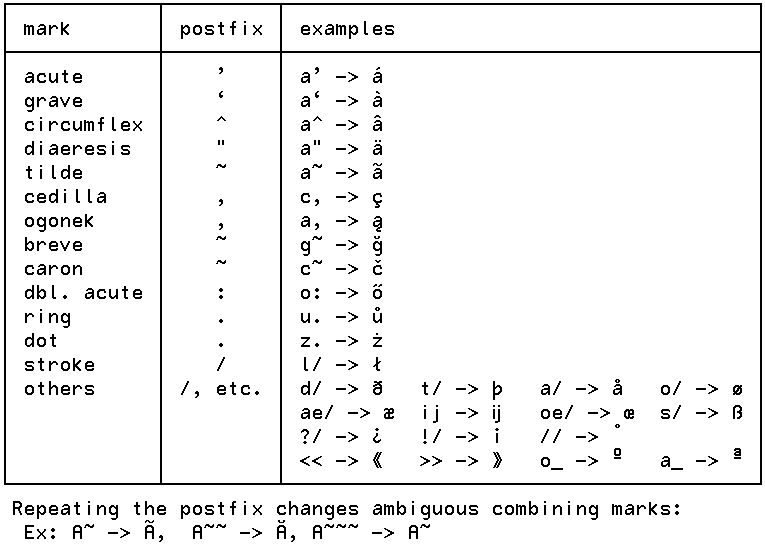
-
latn-pre (language:generic name:latn-pre
 )Input method for Latin script with prefix modifiers.
)Input method for Latin script with prefix modifiers.
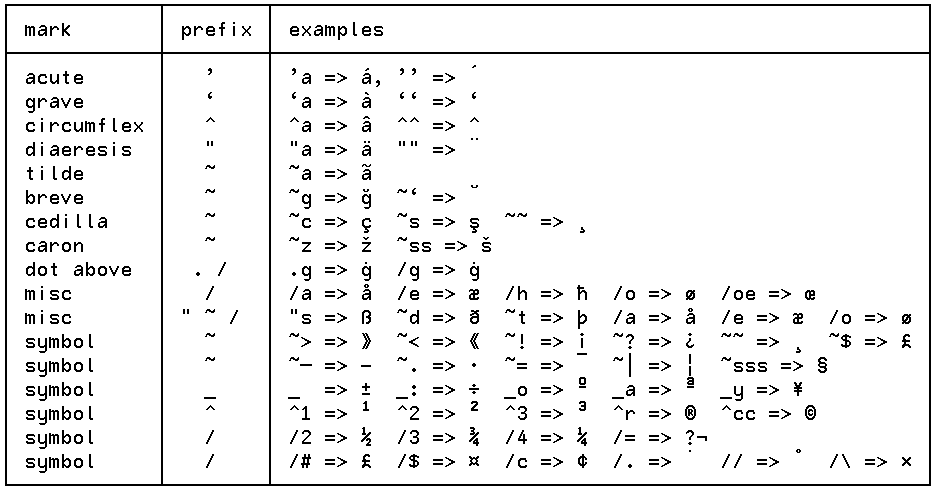
-
latn1-pre (language:generic name:latn1-pre
 )Input method for Latin script with prefix modifiers and AltGr combinations.
)Input method for Latin script with prefix modifiers and AltGr combinations.
-
lo-kbd (language:lo name:kbd
 )Input method for Lao using Lao keyboard layout.
)Input method for Lao using Lao keyboard layout.
-
lo-lrt.mim (language:lo name:lrt icon:
 )
)Lao input method using Lao-Roman transliteration.
-
lsymbol.mim (language:generic name:lsymbol icon:
 )
)Input method for symbols with relatively longer key sequences. It provides access to a broad category of symbols by using the technique of showing multiple alternatives based on the starter keys pressed. For instance, "/->" -> arrows (e.g. →←↑↓ 👉👈👆👇✋ ►◄▲▾ ◤◥◣◢) "/||" -> hand genstures (e.g. 👍👎👍👎👌✋👏🙆 🙏👋🙌✌✊👊 💁🙋💪✍💆💅) "/:)" -> happy faces (e.g. ☺️ 😃😅😆😉😇 😂😏😛😜😝😋 😉💏💋😍😘😚 😽😻) "/:(" -> unhappy faces (e.g. 😢😩😡😭😪 🙈🙊🙉) "/<3" -> hearts (e.g. ♥️🤍️💔💖💘 💓💞💕💌💑😍😘) "/&&" -> spiritual (e.g. 💀☠️👹👼😇 ☸️✡️☯️✝️☦️☪️ 🕉️🛐☮️🕎🪯 💒⛪🙈🙊🙉 卍卐☯☬✙) "/xx" -> checks (e.g. ✔✘☐☑☒) "/$" -> currency (e.g. €£¥﷼₱₹ 💰💵💶💴💷) "/@" -> legal/text signs (e.g ©®™§¶†‡) "/^" -> math symbols (e.g. √) "/z" -> zodiac symbols (e.g. ♈♉♊♋♌♍ ♎♏♐♑♒♓) "/p" -> astrological planet symbols (e.g. ☉☽☿♀⊕♂♃♄♅♆♇) "/ " -> zero width joiners (currently only U+ZERO WIDTH NON-JOINER) The user can select the appropriate symbol using ↑,↓,→,← (or C-p, C-n, C-f, C-b) keys and/or the digits. Other miscellaneous keys are: "//" -> "/" "/..." -> "…" This input methods is registered as one of fallback input methods by default. See the documentation page of m17n input methods for more detail. <http://www.nongnu.org/m17n/manual-en/m17nDBData.html#mim-list> -
mai-inscript.mim (language:mai name:inscript icon:
 )
)Maithili input method for inscript layout. Reference URL : http://indlinux.org/wiki/index.php/InscriptLayouts#Devanagari Key Summary: 1. ज्ञ : % This can also be typed as a sequence of following: ज + ् + ञ i.e. p + d + } 2. त्र : ^ This can also be typed as a sequence of following: त + ् + र i.e. l + d + j 3. क्ष : & This can also be typed as a sequence of following: क + ् + ष i.e. k + d + < 4. श्र : * This can also be typed as a sequence of following: श + ् + र i.e. M + d + j Key summary: Rajesh Ranjan <rranjan@redhat.com> -
mai-inscript2.mim (language:mai name:inscript2 icon:
 )
)Maithili input method for enhanced inscript layout. Reference URL - http://ildc.in/Inscript-layout.html Use AltGr (Alt_R key) to type the following characters: Character Key ---------------------------- ZWJ AltGr + 1 ZWNJ AltGr + 2 ₹ AltGr + 4
-
math-latex.mim (language:generic name:math-latex icon:
 )
)Mathematics input method using LaTeX command names.
-
ml-enhanced-inscript.mim (language:ml name:enhanced-inscript icon:
 )
)Malayalam input method for enhanced inscript layout. INSCRIPT (Indian Script) is a keyboard layout scheme to input Indic text on computer, standardized by Government of India. This input method is based on Enhanced Inscript which supports atomic chillu. Author: Jithin Thankachan <jithin@space-kerala.org>
-
ml-inscript.mim (language:ml name:inscript icon:
 )
)Malayalam input method for inscript layout. INSCRIPT (Indian Script) is a keyboard layout scheme to input Indic text on computer, standardized by Government of India. Each key on keyboard is mapped to a Malayalam alphabet. Once SCIM is activated, select Malayalam Inscript from the SCIM tab appearing on the down right corner and input Malayalam text. To type 0-9 in Malayalam press 0-9 on Inscript keyboard. For English numerals, switch back to English keyboard using control + space bar and press 0-9. INSCRIPT KEYBOARD LAYOUT is available at: http://fedoraproject.org/wiki/I18N/Indic/MalayalamKeyboardLayouts http://tdil.mit.gov.in/isciichart.pdfwill be provided in the next release. IMPORTANT: 1. key ']' is mapped to Zero Width Joiner (ZWJ) which helps you to write the five chillaksharam. 2. key '\' is mapped to Zero Width Non Joiner (ZWNJ) which helps you to stop the consonants from joining to form conjuncts. [Note: consonants are ക, ഖ, ഗ,..... and conjuncts are those formed using two consonants like ക്ക, ഗ്ഗ, ന്ത, ക്യ, ക്വ, ....] Following are the conjuncts formed in our language, shown along with the keys to reproduce them: Case 1: CHILLU aksharam: (i) ന് = ന + ് + zero width joiner(zwj) ie, key 'V' + key 'D' + key ']' (ii) ല് = ല + ് + zero width joiner(zwj) ie, key 'N' + key 'D' + key ']' (iii) ര് = ര + ് + zero width joiner(zwj) ie, key 'J' + key 'D' + key ']' (iv) ണ് = ണ + ് + zero width joiner(zwj) ie, shift key 'C' + key 'D' + key ']' (v) ള് = ള + ് + zero width joiner(zwj) ie, shift key 'N' + key 'D' + key ']' Case 2: (i) ങ്ങ = ങ + ് + ക ie, shift key 'U' + key 'D' + key 'K' (ii) ന്ത = ന + ് + ത ie, key 'V' + key 'D' + key 'L' (iii) ഞ്ച = ഞ + ് + ച ie, shift key '}' + key 'D' + key ';' (iv) ണ്ട = ണ + ് + ട ie, shift key 'C' + key 'D' + key '"' (v) മ്പ = മ + ് + പ ie, key 'V' + key 'D' + key 'H' (vi) ക്ഷ = ക + ് + ഷ ie, key 'C' + key 'D' + shift key '<' Case 3: Koottaksharangal: (i) ക്ക = ക + ് + ക ie, key 'K' + key 'D' + key 'K' (ii) ങ്ങ = ങ + ് + ങ ie, shift key 'U' + key 'D' + shift key 'U' (iii) ച്ച = ച + ് + ച ie, key ';' + key 'D' + key ';' (iv) ഞ്ഞ = ഞ + ് + ഞ ie, shift key '}' + key 'D' + shift key '}' (v) ട്ട = ട + ് + ട ie, key '"' + key 'D' + key '"' (vi) ണ്ണ = ണ + ് + ണ ie, shift key 'C' + key 'D' + shift key 'C' (vii) ത്ത = ത + ് + ത ie, key 'L' + key 'D' + key 'L' (viii) ന്ന = ന + ് + ന ie, key 'V' + key 'D' + key 'V' (ix) മ്മ = മ + ് + മ ie, key 'C' + key 'D' + key 'C' (x) ല്ല = ല + ് + ല ie, key 'N' + key 'D' + key 'N' (xi) വ്വ = വ + ് + വ ie, key 'B' + key 'D' + key 'B' (xii) യ്യ = യ + ് + യ ie, key '?' + key 'D' + key '?' (xiii) ശ്ശ = ശ + ് + ശ ie, shift key 'M' + key 'D' + shift key 'M' (xiv) സ്സ = സ + ് + സ ie, key 'M' + key 'D' + key 'M' (xv) ള്ള = ള + ് + ള ie, shift key 'N' + key 'D' + shift key 'N' (xvi) റ്റ = റ + ് + റ ie, shift key 'J' + key 'D' + shift key 'J' Case 4: (Following conjuncts are explained with the help of consonant 'ക') (1) Conjuncts formed with ര (ra): ക്ര = ക + ് + ര ie, key 'K' + key 'D' + key 'J' (2) Conjuncts formed with യ (ya): ക്യ = ക + ് + യ ie, key 'K' + key 'D' + key '?' (3) Conjuncts formed with വ (va): ക്വ = ക + ് + വ ie, key 'K' + key 'D' + key 'B' Special case: ന്റ = ന + ് + റ ie, key 'V' + key 'D' + shift key 'J' Author: Ani Peter <apeter@redhat.com> -
ml-inscript2.mim (language:ml name:inscript2 icon:
 )
)Malayalam input method for enhanced inscript layout. Reference URL - http://ildc.in/Inscript-layout.html Use AltGr (Alt_R key) to type the following characters: Character Key ---------------------------- ZWJ AltGr + 1 ZWNJ AltGr + 2 ₹ AltGr + 4 Following are the conjuncts formed in our language, shown along with the keys to reproduce them: Case 1: CHILLU aksharam: (i) ന് = ന + ് + zero width joiner(zwj) ie, key 'v' + key 'd' + key <AltGr+1> (ii) ല് = ല + ് + zero width joiner(zwj) ie, key 'n' + key 'd' + key <AltGr+1> (iii) ര് = ര + ് + zero width joiner(zwj) ie, key 'j' + key 'd' + key <AltGr+1> (iv) ണ് = ണ + ് + zero width joiner(zwj) ie, shift key 'c' + key 'd' + key <AltGr+1> (v) ള് = ള + ് + zero width joiner(zwj) ie, shift key 'n' + key 'd' + key <AltGr+1> Case 2: (i) ങ്ങ = ങ + ് + ക ie, shift key 'u' + key 'd' + key 'k' (ii) ന്ത = ന + ് + ത ie, key 'v' + key 'd' + key 'l' (iii) ഞ്ച = ഞ + ് + ച ie, shift key '}' + key 'd' + key ';' (iv) ണ്ട = ണ + ് + ട ie, shift key 'c' + key 'd' + key ''' (v) മ്പ = മ + ് + പ ie, key 'v' + key 'd' + key 'h' (vi) ക്ഷ = ക + ് + ഷ ie, key 'c' + key 'd' + shift key ',' Case 3: Koottaksharangal: (i) ക്ക = ക + ് + ക ie, key 'k' + key 'd' + key 'k' (ii) ങ്ങ = ങ + ് + ങ ie, shift key 'u' + key 'd' + shift key 'u' (iii) ച്ച = ച + ് + ച ie, key ';' + key 'd' + key ';' (iv) ഞ്ഞ = ഞ + ് + ഞ ie, shift key '}' + key 'd' + shift key '}' (v) ട്ട = ട + ് + ട ie, key ''' + key 'd' + key ''' (vi) ണ്ണ = ണ + ് + ണ ie, shift key 'c' + key 'd' + shift key 'c' (vii) ത്ത = ത + ് + ത ie, key 'l' + key 'd' + key 'l' (viii) ന്ന = ന + ് + ന ie, key 'v' + key 'd' + key 'v' (ix) മ്മ = മ + ് + മ ie, key 'c' + key 'd' + key 'c' (x) ല്ല = ല + ് + ല ie, key 'n' + key 'd' + key 'n' (xi) വ്വ = വ + ് + വ ie, key 'b' + key 'd' + key 'b' (xii) യ്യ = യ + ് + യ ie, key '/' + key 'd' + key '/' (xiii) ശ്ശ = ശ + ് + ശ ie, shift key 'm' + key 'd' + shift key 'm' (xiv) സ്സ = സ + ് + സ ie, key 'm' + key 'd' + key 'm' (xv) ള്ള = ള + ് + ള ie, shift key 'n' + key 'd' + shift key 'n' (xvi) റ്റ = റ + ് + റ ie, shift key 'j' + key 'd' + shift key 'j' Case 4: (Following conjuncts are explained with the help of consonant 'ക') (1) Conjuncts formed with ര (ra): ക്ര = ക + ് + ര ie, key 'k' + key 'd' + key 'j' (2) Conjuncts formed with യ (ya): ക്യ = ക + ് + യ ie, key 'k' + key 'd' + key '/' (3) Conjuncts formed with വ (va): ക്വ = ക + ് + വ ie, key 'k' + key 'd' + key 'b' Special case: ന്റ = ന + ് + റ ie, key 'v' + key 'd' + shift key 'j' Author: Ani Peter <apeter@redhat.com> -
ml-itrans.mim (language:ml name:itrans icon:
 )
)Malayalam input method by ITRANS transliteration. Itrans keyboard helps you to type the way you speak. For instance, if your input method framework is SCIM, activate it and select Malayalam Itrans from the SCIM tab appearing on the down right corner. Then you can input Malayalam text with the help of following keys. Key - Consonant k - ക് ~n - ഞ് n - ന് ld - ള് kh - ഖ് JN - ഞ് p - പ് v - വ് g - ഗ് T - ട് ph - ഫ് w - വ് gh - ഘ് Th - ഠ് b - ബ് sh - ശ് ~N - ങ് D - ഡ് bh - ഭ് Sh - ഷ് N^ - ങ് Dh - ഢ് m - മ് shh - ഷ് ch - ച് N - ണ് y - യ് s - സ് Ch - ഛ് t - ത് r - ര് h - ഹ് chh - ഛ് th - ഥ് rh - റ് GY - ജ്ഞ് j - ജ് d - ദ് l - ല് dny - ജ്ഞ് jh - ഝ് dh - ധ് L - ള് x - ക്ഷ്) Key - Vowel a - അ I - ഈ R^i - ഋ ee - ഏ au - ഔ aa - ആ u - ഉ LLi - ഌ ai - ഐ A - ആ uu - ഊ L^i - ഌ o - ഒ i - ഇ U - ഊ e - എ oo - ഓ ii - ഈ RRi - ഋ E - ഏ O - ഓ Key - Misc 0 - ൦ 5 - ൫ .n - ം # - ്ര 1 - ൧ 6 - ൬ M - ം $ - ര് 2 - ൨ 7 - ൭ H - ഃ ^ - ത്ര 3 - ൩ 8 - ൮ .h - ് * - ശ്ര 4 - ൪ 9 - ൯ For more information refer to following: http://fedoraproject.org/wiki/I18N/Indic/MalayalamKeyboardLayouts For the detail of ITRANS, see the page: <http://www.aczoom.com/itrans/>
-
ml-mozhi.mim (language:ml name:mozhi icon:
 )
)Malayalam input method. For the details, see the page: <http://chithrangal.blogspot.com/2012/02/ml-mozhi.html>
-
ml-remington.mim (language:ml name:remington icon:
 )
)Malayalam input method for Remington typewriter layout. The detailed information is available <http://wiki.smc.org.in/Remington>. Author: Sebin Abraham Jacob <sebinajacob@gmail.com>, Icons: Hiran Venugopal <hiran.v@gmail.com>
-
ml-swanalekha.mim (language:ml name:swanalekha icon:
 )
)Swanalekha Malayalam input method For detailed documentation, refer https://swanalekha.smc.org.in
-
mni-inscript2-beng.mim (language:mni name:inscript2-beng icon:
 )
)Manipuri input method for enhanced inscript layout. Reference URL - http://ildc.in/Inscript-layout.html Use AltGr (Alt_R key) to type the following characters: Character Key ---------------------------- ZWJ AltGr + 1 ZWNJ AltGr + 2 ₹ AltGr + 4
-
mni-inscript2-mtei.mim (language:mni name:inscript2-mtei icon:
 )
)Manipuri Meetei Mayek input method for enhanced inscript layout. Reference URL - http://ildc.in/Inscript-layout.html Use AltGr (Alt_R key) to type the following characters: Character Key ---------------------------- ZWJ AltGr + 1 ZWNJ AltGr + 2 ₹ AltGr + 4
-
mr-gamabhana.mim (language:mr name:gamabhana icon:
 )
)Based on Hindi input method by ITRANS and Harvard-Kyoto transliteration systems. You can use all the standard ITRANS key sequences plus key sequences such as the below. nk->ङ्क्, nkh->ङ्ख्, ng->ङ्ग्, ngh->ङ्घ् nch->ञ्च्, nCh->ञ्छ्, nc->ञ्च्, nC->ञ्छ्, nchh->ञ्छ्, nj->ञ्ज्, njh->ञ्झ्, nT->ण्ट्, nTh->ण्ठ्, nD->ण्ड्, nDh->ण्ढ् c->च्, C->छ्, z->श्, S->ष्, jn->ज्ञ्, R->ऋ In addition, for convenience, when a consonant + halant sequence is followed by non Devanagari letter, the last halant is removed. For instance, 'k SPC'->'क ', 'k..'->'क।'. The motivation behind additions made to the basic ITRANS scheme is described in http://sanskritnlp.appspot.com/optitrans.html, along with a tabulated comparison with several other transliteration schemes. Also, see: http://en.wikipedia.org/wiki/Devanagari_transliteration.
-
mr-inscript.mim (language:mr name:inscript icon:
 )
)Marathi input method for inscript layout. Reference URL - http://indlinux.org/wiki/index.php/InscriptLayouts#Marathi Key Summary: 1. ज्ञ : % This can also be typed as a sequence of following: ज + ् + ञ i.e. p + d + } 2. त्र : ^ This can also be typed as a sequence of following: त + ् + र i.e. l + d + j 3. क्ष : & This can also be typed as a sequence of following: क + ् + ष i.e. k + d + < 4. श्र : * This can also be typed as a sequence of following: श + ् + र i.e. M + d + j Author : Rahul Bhalerao <rbhalera@redhat.com> -
mr-inscript2.mim (language:mr name:inscript2 icon:
 )
)Marathi input method for enhanced inscript layout. Reference URL - http://ildc.in/Inscript-layout.html Use AltGr (Alt_R key) to type the following characters: Character Key ---------------------------- ZWJ AltGr + 1 ZWNJ AltGr + 2 ₹ AltGr + 4
-
mr-itrans.mim (language:mr name:itrans icon:
 )
)Marathi input method by ITRANS transliteration. For the detail of ITRANS, see the page: <http://www.aczoom.com/itrans/> Author: Rahul Bhalerao <rbhalera@redhat.com>
-
mr-modi-itrans.mim (language:mr name:modi-itrans icon:
 )
)Marathi modi input method by ITRANS and Harvard-Kyoto transliteration systems. You can use all the standard ITRANS key sequences plus key sequences such as the below. nk->𑘒𑘿𑘎𑘿, nkh->𑘒𑘿𑘏𑘿, ng->𑘒𑘿𑘐𑘿, ngh->𑘒𑘿𑘑𑘿 nch->𑘗𑘿𑘓𑘿, nCh->𑘗𑘿𑘔𑘿, nc->𑘗𑘿𑘓𑘿, nC->𑘗𑘿𑘔𑘿, nchh->𑘗𑘿𑘔𑘿, nj->𑘗𑘿𑘕𑘿, njh->𑘗𑘿𑘖𑘿, nT->𑘜𑘿𑘘𑘿, nTh->𑘜𑘿𑘙𑘿, nD->𑘜𑘿𑘚𑘿, nDh->𑘜𑘿𑘛𑘿 c->𑘓𑘿, C->𑘔𑘿, z->𑘫𑘿, S->𑘬𑘿, jn->𑘕𑘿𑘗𑘿, R->𑘨𑘲 In addition, for convenience, when a consonant + halant sequence is followed by non Devanagari letter, the last halant is removed. For instance, 'k SPC'->'𑘎 ', 'k..'->'𑘎𑙁'. The motivation behind additions made to the basic ITRANS scheme is described in https://sanskrit-coders.github.io/input/optitrans/, along with a tabulated comparison with several other transliteration schemes. Also, see: http://en.wikipedia.org/wiki/Devanagari_transliteration.
-
mr-phonetic.mim (language:mr name:phonetic icon:
 )
)Marathi input method for phonetic layout. Key Summary: 1. ज्ञ : ^ This can also be typed as a sequence of following: ज + ् + ञ i.e. j +f + % 2. त्र : not available here shd be one This can also be typed as a sequence of following: त + ् + र i.e. t + f + r 3. क्ष : X This can also be typed as a sequence of following: क + ् + ष i.e. k + f + x 4. श्र : * This can also be typed as a sequence of following: श + ् + र i.e. S + f + r Author: Mayank Jain <majain@redhat.com> -
mr-remington.mim (language:mr name:remington icon:
 )
)Marathi input method for remington layout. Author: sudhakar u <sudhakaru@cdac.in>
-
mr-typewriter.mim (language:mr name:typewriter icon:
 )
)Marathi input method for typewriter layout. Author: sudhakar u <sudhakaru@cdac.in>
-
my-kbd.mim (language:my name:kbd icon:
 )
)Myanmar input method simulating the Myanmar keyboard.
-
ne-inscript2-deva.mim (language:ne name:inscript2-deva icon:
 )
)Nepali input method for enhanced inscript layout. Reference URL - http://ildc.in/Inscript-layout.html Use AltGr (Alt_R key) to type the following characters: Character Key ---------------------------- ZWJ AltGr + 1 ZWNJ AltGr + 2 ₹ AltGr + 4
-
ne-rom-translit.mim (language:ne name:rom-translit icon:
 )
)Nepali input method by roman transliteration.
-
ne-rom.mim (language:ne name:rom icon:
 )
)Nepali input method for romanized layout. Author: Suyash Shrestha <suyash.shr@gmail.com>
-
ne-trad-ttf.mim (language:ne name:trad-ttf icon:
 )
)Nepali input method with ttf-fonts like layout. Author: Santosh Pradhan <sapradhan8@gmail.com>
-
ne-trad.mim (language:ne name:trad icon:
 )
)Nepali input method for traditional layout. Author: Suyash Shrestha <suyash.shr@gmail.com>
-
new-newa-traditional.mim (language:new name:newa-traditional icon:
 )
)Input method for Prachalit Newa script. Author: Santosh Pradhan <sapradhan8@gmail.com>
-
nsk-phonetic (language:nsk name:phonetic
 )Input method for Naskapi language
)Input method for Naskapi language
-
oj-phonetic (language:oj name:phonetic
 )Input method for Ojibwe languages
)Input method for Ojibwe languages
-
or-inscript.mim (language:or name:inscript icon:
 )
)Oriya input method for inscript layout. Reference URL - http://indlinux.org/wiki/index.php/InscriptLayouts#Oriya Key Summary: 1. ଜ୍ଞ : % This can also be typed as a sequence of following: ଜ + ୍ + ଞ i.e. p + d + } 2. ତ୍ର : ^ This can also be typed as a sequence of following: ତ + ୍ + ର i.e. l + d + j 3. କ୍ଷ : & This can also be typed as a sequence of following: କ + ୍ + ଷ i.e. k + d + < 4. ଶ୍ର : * This can also be typed as a sequence of following: ଶ + ୍ + ର i.e. M + d + j Author: Subhransu Behera <sbehera@redhat.com> Key summary: Subhransu Behera <sbehera@redhat.com>
-
or-inscript2.mim (language:or name:inscript2 icon:
 )
)Odia input method for enhanced inscript layout. Reference URL - http://ildc.in/Inscript-layout.html Use AltGr (Alt_R key) to type the following characters: Character Key ---------------------------- ZWJ AltGr + 1 ZWNJ AltGr + 2 ₹ AltGr + 4
-
or-itrans.mim (language:or name:itrans icon:
 )
)Oriya input method by ITRANS transliteration. For the detail of ITRANS, see the page: <http://www.aczoom.com/itrans/>
-
or-phonetic.mim (language:or name:phonetic icon:
 )
)Oriya input method for phonetic layout. 1. ଜ୍ଞ : ^ This can also be typed as a sequence of following: ଜ + ୍ + ଞ i.e. j +f + % 2. ତ୍ର :# This can also be typed as a sequence of following: ତ + ୍ + ର i.e. t + f + r 3. କ୍ଷ : X This can also be typed as a sequence of following: କ + ୍ + ଷ i.e. k + f + x 4. ଶ୍ର : * This can also be typed as a sequence of following: ଶ + ୍ + ର i.e. S + f + r Author: Subhranshu Behera <sbehera@redhat.com> -
pa-anmollipi.mim (language:pa name:anmollipi icon:
 )
)Punjabi input method for AnmolLipi (Phonetic). Author: Parag Nemade <pnemade@redhat.com>
-
pa-inscript.mim (language:pa name:inscript icon:
 )
)Punjabi input method for inscript layout. Key summary: Some complex Characters z=ੰ Z=ੱ |=। /=ਯ D=੍ (halant to type Parian character like Ra/Ha) The conjuncts called HALANT letters can be used using the following keys: (i) Consonant + RA ie, key 'K' + key 'D' + key 'J' (ii) Consonant + HA ie, key 'K' + key 'D' + key 'U' (iii) Consonant + VA ie, key 'K' + key 'D' + key 'B' (iv) Consonant + YA ie, key 'K' + key 'D' + key '/' Key summary: AP Singh Brar <apbrar@gmail.com>, Jaswinder Singh <jsingh@redhat.com>
-
pa-inscript2-guru.mim (language:pa name:inscript2-guru icon:
 )
)Punjabi input method for enhanced inscript layout. Reference URL - http://ildc.in/Inscript-layout.html Use AltGr (Alt_R key) to type the following characters: Character Key ---------------------------- ZWJ AltGr + 1 ZWNJ AltGr + 2 ₹ AltGr + 4 Key summary: Some complex Characters d=੍ (halant to type Parian character like Ra/Ha) The conjuncts called HALANT letters can be used using the following keys: (i) Consonant + RA ie, key 'K' + key 'd' + key 'j' (ii) Consonant + HA ie, key 'K' + key 'd' + key 'u' (iii) Consonant + VA ie, key 'K' + key 'd' + key 'b' (iv) Consonant + YA ie, key 'K' + key 'd' + key '/' Key summary: AP Singh Brar <apbrar@gmail.com>, Jaswinder Singh <jsingh@redhat.com>
-
pa-itrans.mim (language:pa name:itrans icon:
 )
)Panjabi input method by ITRANS transliteration. For the detail of ITRANS, see the page: <http://www.aczoom.com/itrans/>
-
pa-jhelum.mim (language:pa name:jhelum icon:
 )
)Punjabi input method for jhelum layout. Key Summary: Some complex Characters z=ੱ Z=਼ x=ਂ X=ੰ |=। D=੍ (halant to type Parian character like Ra/Ha) The conjuncts called HALANT letters can be used using the following keys: (i) Consonant + RA ie, key 'K' + key 'D' + key 'J' (ii) Consonant + HA ie, key 'K' + key 'D' + key 'U' (iii) Consonant + VA ie, key 'K' + key 'D' + key 'B' (iv)Consonant + YA ie, key 'K' + key 'D' + key '/' Key summary: AP Singh Brar <apbrar@gmail.com>, Jaswinder Singh <jsingh@redhat.com>
-
pa-phonetic.mim (language:pa name:phonetic icon:
 )
)Punjabi input method for phonetic layout. Author: Jatin Nansi <jnansi@redhat.com>
-
pa-remington.mim (language:pa name:remington icon:
 )
)Punjabi input method for remington layout. Author: sudhakar u <sudhakaru@cdac.in>
-
ps-phonetic.mim (language:ps name:phonetic icon:
 )
)Pashto input method for phonetic layout. Author: Michaël Monzo <elbrazotontodelaley@free.fr>
-
rfc1345.mim (language:generic name:rfc1345 icon:
 )
)Generic input method using RFC1345 mnemonics. Input characters by typing & (ampersand) followed by two or three keys. It doesn not include RFC1345 mnemonics for ASCII except for the following characters: &SP 0020 SPACE &Nb 0023 NUMBER SIGN &DO 0024 DOLLAR SIGN && 0026 AMPERSAND &At 0040 COMMERCIAL AT &<( 005b LEFT SQUARE BRACKET &// 005c REVERSE SOLIDUS &)> 005d RIGHT SQUARE BRACKET &'> 005e CIRCUMFLEX ACCENT &'! 0060 GRAVE ACCENT
-
ru-kbd (language:ru name:kbd
 )Input method for Russian by simulating the Russian keyboard.
)Input method for Russian by simulating the Russian keyboard.
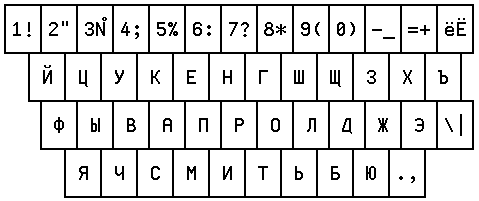 Keyboard Layout
Keyboard Layout -
ru-phonetic (language:ru name:phonetic
 )Input method for Russian simulating the keyboard layout based on
)Input method for Russian simulating the keyboard layout based on
Roman transcription by phonetic resemblance.
 Keyboard Layout
Keyboard Layout -
ru-translit.mim (language:ru name:translit icon:
 )
)Intuitively transliterated keyboard layout. Most convenient for entering Russian, but all Cyrillic characters are included. Should handle most cases. However: for ц (TSE) use "c", never "ts" щ (SHCHA = Bulgarian SHT) = "shch", "sj", "/sht" or "/t", э (REVERSE ROUNDED E) = "e'" or "e`" х (KHA) when after с (S) = "x" or "kh" ъ (HARD SIGN) = "~", Ъ (CAPITAL HARD SIGN) = "~~", ь (SOFT SIGN) = "'", Ь (CAPITAL SOFT SIGN) = "''", я (YA) = "ya", "ja" or "q". Russian alphabet: a b v=w g d e yo=jo zh z i j=j' k l m n o p r s t u f h=kh=x c ch sh shch=/s=/sht ~ y ' e' yu=ju ya=ja=q Also included are Ukrainian є (YE) = "/e" and ї (YI) = "yi", Belarusian ў (SHORT U) = "u'", Serbo-Croatian ђ (DJE) = "/d", ћ (CHJE)= "/ch", Macedonian ѓ (GJE) = "/g", ѕ (DZE) = "/s", ќ (KJE) = "/k", cyrillic і (I DECIMAL) = "/i", ј (JE) = "/j", љ (LJE) = "/l", њ (NJE) = "/n" and џ (DZE) ="/z".
-
ru-yawerty (language:ru name:yawerty
 )Input method for Russian simulating the keyboard layout based on
)Input method for Russian simulating the keyboard layout based on
Roman transcription by phonetic resemblance.
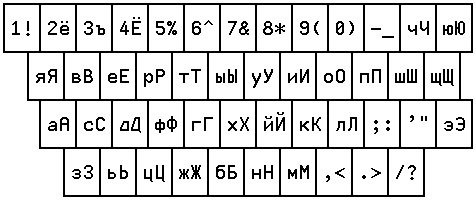 Keyboard Layout
Keyboard LayoutWhen preceded by a '/', the second and the third rows (number key
row) change as follows.

-
sa-brahmi-itrans.mim (language:sa name:brahmi-itrans icon:
 )
)Sanskrit brahmi input method by ITRANS and Harvard-Kyoto transliteration systems. You can use all the standard ITRANS key sequences plus key sequences such as the below. nk->𑀗𑁆𑀓𑁆, nkh->𑀗𑁆𑀔𑁆, ng->𑀗𑁆𑀕𑁆, ngh->𑀗𑁆𑀖𑁆 nch->𑀜𑁆𑀘𑁆, nCh->𑀜𑁆𑀙𑁆, nc->𑀜𑁆𑀘𑁆, nC->𑀜𑁆𑀙𑁆, nchh->𑀜𑁆𑀙𑁆, nj->𑀜𑁆𑀚𑁆, njh->𑀜𑁆𑀛𑁆, nT->𑀡𑁆𑀝𑁆, nTh->𑀡𑁆𑀞𑁆, nD->𑀡𑁆𑀟𑁆, nDh->𑀡𑁆𑀠𑁆 c->𑀘𑁆, C->𑀙𑁆, z->𑀰𑁆, S->𑀱𑁆, jn->𑀚𑁆𑀜𑁆, R->𑀋 _->॒, ''->॑ For motivations and further details, see description of hi-brahmi-itrans.mim.
-
sa-grantha-itrans.mim (language:sa name:grantha-itrans icon:
 )
)Sanskrit grantha input method by ITRANS and Harvard-Kyoto transliteration systems. You can use all the standard ITRANS key sequences plus key sequences such as the below. nk->𑌙𑍍𑌕𑍍, nkh->𑌙𑍍𑌖𑍍, ng->𑌙𑍍𑌗𑍍, ngh->𑌙𑍍𑌘𑍍 nch->𑌞𑍍𑌚𑍍, nCh->𑌞𑍍𑌛𑍍, nc->𑌞𑍍𑌚𑍍, nC->𑌞𑍍𑌛𑍍, nchh->𑌞𑍍𑌛𑍍, nj->𑌞𑍍𑌜𑍍, njh->𑌞𑍍𑌝𑍍, nT->𑌣𑍍𑌟𑍍, nTh->𑌣𑍍𑌠𑍍, nD->𑌣𑍍𑌡𑍍, nDh->𑌣𑍍𑌢𑍍 c->𑌚𑍍, C->𑌛𑍍, z->𑌶𑍍, S->𑌷𑍍, jn->𑌜𑍍𑌞𑍍, R->𑌋 _->॒, ''->᳴
-
sa-harvard-kyoto.mim (language:sa name:harvard-kyoto icon:
 )
)Sanscrit input method with Harvard-Kyoto convention. The table is based on <http://en.wikipedia.org/wiki/Harvard-Kyoto>
-
sa-iast-vedic.mim (language:sa name:IAST-vedic icon:
 )
)Romanized Sanskrit input method with IAST and ISO 15919 conventions. The table is based on <http://en.wikipedia.org/wiki/International_Alphabet_of_Sanskrit_Transliteration> and https://en.wikipedia.org/wiki/ISO_15919. Some widely used Vedic accents in postfix notation are also supported (See: https://en.wikipedia.org/wiki/Vedic_accent).
-
sa-iast.mim (language:sa name:IAST icon:
 )
)Romanized Sanskrit input method with IAST/ISO 15919 convention. The table is based on <http://en.wikipedia.org/wiki/International_Alphabet_of_Sanskrit_Transliteration> and https://en.wikipedia.org/wiki/ISO_15919.
-
sa-inscript.mim (language:sa name:inscript icon:
 )
)Sanskrit input method for inscript layout. Reference URL : http://indlinux.org/wiki/index.php/InscriptLayouts#Devanagari Key Summary: 1. ज्ञ : % This can also be typed as a sequence of following: ज + ् + ञ i.e. p + d + } 2. त्र : ^ This can also be typed as a sequence of following: त + ् + र i.e. l + d + j 3. क्ष : & This can also be typed as a sequence of following: क + ् + ष i.e. k + d + < 4. श्र : * This can also be typed as a sequence of following: श + ् + र i.e. M + d + j Key summary: Rajesh Ranjan <rranjan@redhat.com> -
sa-inscript2.mim (language:sa name:inscript2 icon:
 )
)Sanskrit input method for enhanced inscript layout. Reference URL - http://ildc.in/Inscript-layout.html Use AltGr (Alt_R key) to type the following characters: Character Key ---------------------------- ZWJ AltGr + 1 ZWNJ AltGr + 2 ₹ AltGr + 4
-
sa-iso-15919-itrans.mim (language:sa name:iso-15919-itrans icon:
 )
)Sanskrit ISO-15919 input method roughly mapped from ITRANS and Harvard-Kyoto transliteration systems. Such a mapping is particularly useful for people who use ITRANS / Harvard-Kyoto based input methods (found for example in sa-itrans.mim) to type sanskrit in other scripts. Not having to memorize multiple input maps for multiple scripts is a plus. You can use all the standard ITRANS key sequences (other than ch, which has a different meaning in this script) plus key sequences such as the below. nk->ṅk, nkh->ṅkh, ng->ṅg, ngh->ṅgh nc->ñc, nch->ñch, nj->ñj, njh->ñjh, nT->ṇṭ, nTh->ṇṭh, nD->ṇḍ, nDh->ṇḍh S->ṣ, jn->jñ, R->r̥ For Sanskrit, e and o are automatically mapped to ē and ō. To type via reconstructed vedic pronunciation (ai=ए, Ai=ऐ, au=ओ, Au=औ) or for dravidian letters, look into using dra-iso-15919-itrans.mim instead. Capital letters may be produced or forced by prefixing a ~, reduplicating a letter (T,D,N,R) for disambiguation where necessary. For example: Raama or ~Raama -> Rāma, ~RRkaara -> R̥kāra, KRShNa or ~KRShNa -> Kr̥ṣṇa, ~Tyaaga -> Tyāga, ~TTakaara -> Ṭakāra, ~Dhiira -> Dhīra, ~DDhakaara -> Ḍhakāra, ~LLakaara -> Ḷakāra The motivation behind additions made to the basic ITRANS scheme is described in https://sanskrit-coders.github.io/input/optitrans/, along with a tabulated comparison with several other transliteration schemes. Also, see: http://en.wikipedia.org/wiki/Devanagari_transliteration.
-
sa-itrans.mim (language:sa name:itrans icon:
 )
)Sanskrit input method by ITRANS and Harvard-Kyoto transliteration systems. You can use all the standard ITRANS key sequences plus key sequences such as the below. nk->ङ्क्, nkh->ङ्ख्, ng->ङ्ग्, ngh->ङ्घ् nch->ञ्च्, nCh->ञ्छ्, nc->ञ्च्, nC->ञ्छ्, nchh->ञ्छ्, nj->ञ्ज्, njh->ञ्झ्, nT->ण्ट्, nTh->ण्ठ्, nD->ण्ड्, nDh->ण्ढ् c->च्, C->छ्, z->श्, S->ष्, jn->ज्ञ्, R->ऋ _->॒, ''->॑ For motivations and further details, see description of hi-itrans.mim.
-
sa-sharada-itrans.mim (language:sa name:sharada-itrans icon:
 )
)Sanskrit sharada input method by ITRANS and Harvard-Kyoto transliteration systems. You can use all the standard ITRANS key sequences plus key sequences such as the below. nk->𑆕𑇀𑆑𑇀, nkh->𑆕𑇀𑆒𑇀, ng->𑆕𑇀𑆓𑇀, ngh->𑆕𑇀𑆔𑇀 nch->𑆚𑇀𑆖𑇀, nCh->𑆚𑇀𑆗𑇀, nc->𑆚𑇀𑆖𑇀, nC->𑆚𑇀𑆗𑇀, nchh->𑆚𑇀𑆗𑇀, nj->𑆚𑇀𑆘𑇀, njh->𑆚𑇀𑆙𑇀, nT->𑆟𑇀𑆛𑇀, nTh->𑆟𑇀𑆜𑇀, nD->𑆟𑇀𑆝𑇀, nDh->𑆟𑇀𑆞𑇀 c->𑆖𑇀, C->𑆗𑇀, z->𑆯𑇀, S->𑆰𑇀, jn->𑆘𑇀𑆚𑇀, R->𑆉 _->॒, ''->॑ For motivations and further details, see description of ks-sharada-itrans.mim.
-
sa-vedic-itrans.mim (language:sa name:vedic-itrans icon:
 )
)Sanskrit input method by a modified version of ITRANS and Harvard-Kyoto transliteration systems with added support for reconstructed vedic pronunciation ai=ए, Ai=ऐ, au=ओ, Au=औ. You can use all the standard ITRANS key sequences plus key sequences such as the below. nk->ङ्क्, nkh->ङ्ख्, ng->ङ्ग्, ngh->ङ्घ् nch->ञ्च्, nCh->ञ्छ्, nc->ञ्च्, nC->ञ्छ्, nchh->ञ्छ्, nj->ञ्ज्, njh->ञ्झ्, nT->ण्ट्, nTh->ण्ठ्, nD->ण्ड्, nDh->ण्ढ् c->च्, C->छ्, z->श्, S->ष्, jn->ज्ञ्, R->ऋ _->॒, ''->॑ For motivations and further details, see description of hi-itrans.mim.
-
sat-inscript2-deva.mim (language:sat name:inscript2-deva icon:
 )
)Santali input method for enhanced inscript layout. Reference URL - http://ildc.in/Inscript-layout.html Use AltGr (Alt_R key) to type the following characters: Character Key ---------------------------- ZWJ AltGr + 1 ZWNJ AltGr + 2 ₹ AltGr + 4
-
sat-inscript2-olck.mim (language:sat name:inscript2-olck icon:
 )
)Santali Ol Chicky input method for enhanced inscript layout. Reference URL - http://ildc.in/Inscript-layout.html Use AltGr (Alt_R key) to type the following characters: Character Key ---------------------------- ₹ AltGr + 4
-
sd-inscript.mim (language:sd name:inscript icon:
 )
)Sindhi input method for inscript layout. Reference URL : http://indlinux.org/wiki/index.php/InscriptLayouts#Devanagari Key Summary: ॻ : This characters can be typed using [ग + '_'(underscore)] or ['i' + '_'] or ['ग'+ ः] ॼ : This characters can be typed using ज + '_'(underscore)] or ['p' + '_'] or ['ज'+ ः] ॾ : This characters can be typed using ड + '_'(underscore)] or ['[' + '_'] or ['ड'+ ः] ॿ : This characters can be typed using ब + '_'(underscore)] or ['y' + '_'] or ['ड'+ ः] Author: Pravin Satpute <psatpute@redhat.com> -
sd-inscript2-deva.mim (language:sd name:inscript2-deva icon:
 )
)Sindhi input method for enhanced inscript layout. Reference URL - http://ildc.in/Inscript-layout.html Use AltGr (Alt_R key) to type the following characters: Character Key ---------------------------- ZWJ AltGr + 1 ZWNJ AltGr + 2 ₹ AltGr + 4
-
si-phonetic-dynamic.mim (language:si name:phonetic-dynamic icon:
 )
)Sinhala phonetic dynamic input method: <http://www.nongnu.org/sinhala/doc/keymaps/sinhala-keyboard_4.html>
-
si-samanala.mim (language:si name:samanala icon:
 )
)Sinhala input method using transliteration. The transleteration system is based on the Samanala version 2 developed by Prasad Dharmasena. <http://www.nongnu.org/sinhala/doc/transliteration/sinhala-transliteration_1.html>
-
si-sayura.mim (language:si name:sayura icon:
 )
)Sinhala input method using the sayura transliteration system. Also, see: https://www.sayura.net/im/ .
-
si-singlish.mim (language:si name:singlish icon:
 )
)Singlish Transliteration Scheme, (C) madura.x86. <http://madurax86.co.nr/singlish.mim> Parts of this file are copyrighted to Harshula Jayasuriya <harshula@gmail.com> Based on original transliteration scheme for Realtime Singlish, <http://realtimesinglish.tk>
-
si-sumihiri.mim (language:si name:sumihiri icon:
 )
)Sinhala input method using transliteration. The transliteration is based on 'sumihiri' scheme developed by Sarath Camillus Jayewardena. <http://www.nongnu.org/sinhala/doc/transliteration/sinhala-transliteration_2.html>
-
si-trans.mim (language:si name:transliteration icon:
 )
)Sinhala transliteration input method: <http://www.nongnu.org/sinhala/doc/transliteration/sinhala-transliteration_5.html>
-
si-wijesekera.mim (language:si name:wijesekera icon:
 )
)Sinhala input method based on SLS 1134 Rev. 2:2004. <http://www.siyabas.lk/docs/sin-kbd-layout5.pdf> Although this code supports both surrounding text and preedit, the former is disabled by default to avoid confusion caused by faulty applications.
-
sk-kbd (language:sk name:kbd
 )Input method for Slovak simulating the standard Slovak keyboard.
)Input method for Slovak simulating the standard Slovak keyboard.
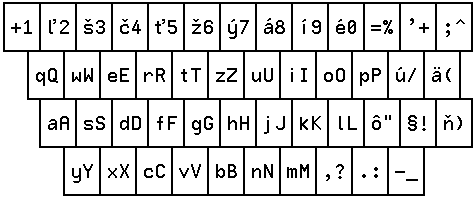 Keyboard Layout
Keyboard LayoutYou can also input more characters by the following key sequences:

-
sr-kbd (language:sr name:kbd
 )Input method for Serbian.
)Input method for Serbian.
Simulating Serbian Cyrillic keyboard on American keyboard.
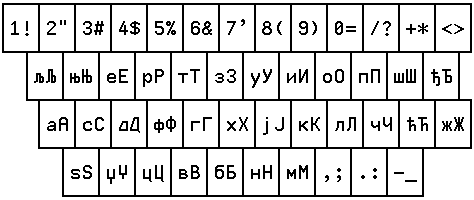 Keyboard Layout
Keyboard Layout -
ssymbol.mim (language:generic name:ssymbol icon:
 )
)Input method for symbols with relatively shorter key sequences. This input methods is suitable for a fallback input method. If you prefer this input method to "lsymbol" which is registered as one of fallback input methods by default, customize the variable "fallback-input-method".
-
sv-post.mim (language:sv name:post icon:
 )
)Swedish input method with postfix modifiers.
-
syrc-phonetic.mim (language:generic name:syrc-phonetic icon:
 )
)Syriac input method simulating the Syriac phonetic keyboard. The keyboard layout was published by Beth Mardutho: The Syriac Institute. <http://www.BethMardutho.org>
-
ta-inscript.mim (language:ta name:inscript icon:
 )
)Tamil input method for inscript layout.
-
ta-inscript2.mim (language:ta name:inscript2 icon:
 )
)Tamil input method for enhanced inscript layout. Reference URL - http://ildc.in/Inscript-layout.html Use AltGr (Alt_R key) to type the following characters: Character Key ---------------------------- ZWJ AltGr + 1 ZWNJ AltGr + 2 ₹ AltGr + 4
-
ta-itrans.mim (language:ta name:itrans icon:
 )
)Tamil input method by ITRANS transliteration. For the detail of ITRANS, see the page: <http://www.aczoom.com/itrans/>
-
ta-lk-renganathan.mim (language:ta name:lk-renganathan icon:
 )
)Tamil input method with Renganathan layout. For the detail, see the page: <http://www.locallanguages.lk/>
-
ta-phonetic.mim (language:ta name:phonetic icon:
 )
)Tamil input method for phonetic layout. Author: Jatin Nansi <jnansi@redhat.com>
-
ta-remington.mim (language:ta name:remington icon:
 )
)Tamil Remington Layout Author: Mohan R <mohan43u@gmail.com> Derived From: https://github.com/thamizha/ekalappai/blob/master/installer/app/keyboards/Tamil-typewriter.txt.in
-
ta-tamil99.mim (language:ta name:tamil99 icon:
 )
)Tamil input method for tamil99 layout. Key Summary: 1. The labels on the keys of Tamil99 keyboard layout consist of, Twelve vowels - அ ஆ இ ஈ உ ஊ எ ஏ ஐ ஒ ஓ ஔ PuLLi - ் , consonant-dot located at ascii "f" Aytham - ஃ Eighteen consonants with inherant vowel "a" - க ங ச ஞ ட ண த ந ப ம ய ர ல வ ழ ள ற ன Five grantham consonants with inherant vowel "a", SRii and KSHA க்ஷ non conjunct form with ZWNJ in between. SRii = <U+0BB6, U+0BCD, U+0BB0, U+0BC0> ஸ ஷ ஜ ஹ க்ஷ ஶ்ரீ 2. A consonant symbol followed by the pulli produces a pure consonant. (A consonant symbol is also known as consonant with inherant a) e.g. க + ் -> க் 3. A consonant symbol followed by a vowel other than the first vowel அ produces a vowelised consonant. e.g. ம + ஆ -> மா த + இ -> தி க + ஒ -> கோ 4. A consonant symbol followed by the same consonant symbol automatically puts a pulli for the first consonant symbol e.g. க + க -> க்க 5. After placing a pulli automatically, this feature of automatic placing of pulli will be disabled temporarily for one stroke. That is, when the same consonant symbol is typed three times continuously one after another, then the first consonants symbol alone gets the pulli automatically, and the second consonant symbol does not get a pulli, since when the third consonant symbol is typed the automatic pulli feature is temporarily disabled. This feature will be restored immediately after that. e.g. க + க + க -> க்கக க + க + க + க -> க்கக்க 6. When the first vowel அ is typed after a consonant symbol, it simply confirms that the previous stroke is an akarameria uyrmei. This disables temporarily the combining of any other stroke with the previous stroke. Hence typing any vowel will not join with the previous consonant symbol. Similarly the automatic pulli feature will also be disabled just for the next stroke. This automatic pulli feature gets restored immediately after the next stroke. The Vowel அ works as the delinking symbol. e.g. க + அ + இ -> கஇ க + அ + க -> கக க + அ + க + க -> கக்க 7. The same behaviour is also seen when a soft consonant symbol is followed by the corresponding hard consonant symbol. (ங, க), (ஞ, ச), (ந, த), (ண, ட), (ம, ப), (ன, ற), are the soft and hard consonants pairs e.g. ங + க -> ங்க ந + த + த -> ந்தத ந + த + த +த -> ந்தத்த ந + அ +த -> நத ந + அ + த + த -> நத்த 8. A vowel after anything other than a consonant symbol will remain an independent vowel e.g ஆ + இ -> ஆஇ ப + ஆ + இ -> பாஇ (இடைவெளி) + உ -> (இடைவெளி)உ # + அ -> #அ Author: I. Felix <ifelix@redhat.com> -
ta-typewriter.mim (language:ta name:typewriter icon:
 )
)Tamil input method for typewriter layout. Author: I. Felix <ifelix@redhat.com>
-
ta-vutam.mim (language:ta name:vutam icon:
 )
)Vutam Type_As_You_Write is suitable for 3 basket mechanical type writers. Meant for those who know to write Tamil. Had the Unicode encoding scheme followed that of TSCII, Vutam can run even in unintelligent keyboards with atleast three baskets. The intelligent SCIM supports many baskets; the third basket is selected in it, by pressing any Alt. key & a Normal key together. Basket one Normal: Short vowels & Consonants. Basket two Shift: Long vowels & consonants with "u" vowel mark. Basket three Alt.: Tamil abbreviations, Numerals & consonants with "U" vowel mark. (H & Alt. h may also be used to get u & U vowel mark hooks.) SCIM's frontend globalsetup trigger may be configured, not to include Alt. grave, since Alt. ` has to produce ` in our layout. Hence the name: VUTAM. The vowel marks: "ai", "e" and "E" to be typed before the consonants, as in writing Tamil. Hence the name: Type_As_You_Write. Key allocation scheme: (1). No logic: & q (2). Script similarity: w & f (3). Convention: z,x & b(big) & (4). Phonetic similarity: Rest. Author: V.Ramasami <v.ramasami@gmail.com>, www.geocities.com/vee_ramasami
-
tai-sonla.mim (language:tai name:sonla-kbd icon:
 )
)Tai Viet input method using the phonetic key sequence with the Tai Son La keyboard layout. The phonetic key sequence means that you type a syllable in this order: C W? V v? F? T? where C is an initial consonant, W is a label for labializing C ('ꪫ'), V is a vowel (V1:prefix, V2:combining, or V3:postfix), v is the second vowel of a digraph vowel (in the case that V is 'ꪹ' and v is 'ꪸ', 'ꪷ', or 'ꪱ'), F is a final consonant, T is a tonemark (spacing or combining). You can type special symbols by these keys: '$' -> 'ꫛ' '#' -> 'ꫜ' '%' -> 'ꫝ' '!' -> '꫞' '@' -> '꫟' -
te-apple.mim (language:te name:apple icon:
 )
)Apple keyboard layout for Telugu
-
te-inscript.mim (language:te name:inscript icon:
 )
)Telugu input method for inscript layout. Key description శ => స్ + హ్ + అ ష => S + హ్ + అ జ్ఞ => జ్ + ఞ్ + అ ర్త్స => ర్ + త్ + స్ + అ కృ => క్ + ఱ్ + ఱ్ + ఇ కై => క్ + అ + ఇ కౌ => క్ + అ + ఉ క్ష => క్ + ష్ + అ స్త్రీ => స్ + త్ + ర్ + ఈ శ్రీ => శ్ + ర్ + ఈ These are the characterstics of the Telugu words 1. Telugu word must be end with vowel (Telugu is a vowel ending language) 2. Telugu words don't have the letter య at the initial position. 3. In telugu we dont use the combination of Sanskrit loan words + native Telugu words. Key summary : Sree Thottempudi <sthottem@redhat.com>
-
te-inscript2.mim (language:te name:inscript2 icon:
 )
)Telugu input method for enhanced inscript layout. Reference URL - http://ildc.in/Inscript-layout.html Use AltGr (Alt_R key) to type the following characters: Character Key ---------------------------- ZWJ AltGr + 1 ZWNJ AltGr + 2 ₹ AltGr + 4 Key description శ => స్ + హ్ + అ ష => S + హ్ + అ ర్త్స => ర్ + త్ + స్ + అ కృ => క్ + ఱ్ + ఱ్ + ఇ కై => క్ + అ + ఇ కౌ => క్ + అ + ఉ స్త్రీ => స్ + త్ + ర్ + ఈ శ్రీ => శ్ + ర్ + ఈ These are the characterstics of the Telugu words 1. Telugu word must be end with vowel (Telugu is a vowel ending language) 2. Telugu words don't have the letter య at the initial position. 3. In telugu we dont use the combination of Sanskrit loan words + native Telugu words. Key summary : Sree Thottempudi <sthottem@redhat.com>
-
te-itrans.mim (language:te name:itrans icon:
 )
)Telugu input method by ITRANS transliteration. For the detail of ITRANS, see the page: <http://www.aczoom.com/itrans/>
-
te-pothana.mim (language:te name:pothana icon:
 )
)pothana Telugu input method Version 2.0 date 24 Nov 2007 Telugu input method by Pothana layout and transliteration (key pairs have fixed one to one mapping), originally proposed by Thirumala Krishna Desikachari along with Pothana font for Windows environments. For the detail of Pothana layout, see the telugu wikipedia page on Pothana font and download the paper available in that page http://te.wikipedia.org/w/index.php?title=%E0%B0%AA%E0%B1%8B%E0%B0%A4%E0%B0%A8_%28%E0%B0%AB%E0%B0%BE%E0%B0%82%E0%B0%9F%E0%B1%81%29&oldid=188094. the key mappings are in the last two pages of the paper. Alt Key gives third level characters and Alt+shift key gives fourth level characters Tested on Fedora core 6 under KDE with default US keyboard layout Please give feedback/bugs to arjunaraoc@googlemail.com. #change from previous version base characters now give vowel endings than halanth # Thanks for your help
-
te-rts.mim (language:te name:rts icon:
 )
)Input method for Telugu script with RTS method. For the detail of RTS, see the page: <http://groups.google.com/groups?selm=Bv0A9M.27B@rice.edu>. This input method is based on the Telugu Rice Transliteration Standard (RTS) specification[1] and its Rice Inverse Transliterator (RIT) supplement[2]. The original RTS specification was written by Ananda Kishore and Rama Rao Kanneganti in 1992 and can presently be accessed in the archives[1] of the 'soc.culture.indian.telugu' USENET newsgroup. The RIT supplement[2] enriches RTS with alternative combinations. However, in cases where RIT and RTS define conflicting mappings for the same combination, such as 'ea', only the RTS mapping is honored. Finally, this input method deviates from the RTS in the following ways: * The combination '@n' yields '�' because its corresponding glyph does not yet exist in the Telugu unicode chart. * The combination 'm' yields 'ం' if it appears at the end of a word. The user can type 'm&' to bypass this behavior and force 'm' to yield 'మ్'. * The sunna prevention operator '&' can be used to force a more literal transliteration of consonant compounds such as 'jn' by writing 'j&n'. [1]: http://groups.google.com/groups?selm=Bv0A9M.27B@rice.edu [2]: http://www.teluguworld.org/RIT/rit3.0/manual.html
-
te-sarala.mim (language:te name:sarala icon:
 )
)Enhanced Sarala Telugu Keyboard layout for Professionals Author: Current developer & maintainer, Satyam Pothamsetti <satyam@teluguvahini.com> Initial layout designer: Krishna Dhullipalla, http://www.medhajananam.org/sarala/
-
th-kesmanee.mim (language:th name:kesmanee icon:
 )
)Thai input method simulating the Kesmanee keyboard with WTT 2.0 input sequence correction. The correction algorithm follows the one shown in the following <http://linux.thai.net/~thep/th-xim/>
-
th-pattachote.mim (language:th name:pattachote icon:
 )
)Thai input method simulating the Pattachote keyboard with WTT 2.0 input sequence correction. The correction algorithm follows the one shown in the following <http://linux.thai.net/~thep/th-xim/>
-
th-tis820.mim (language:th name:tis820 icon:
 )
)Thai input method simulating the TIS-820.2538 keyboard with WTT 2.0 input sequence correction. The correction algorithm follows the one shown in the following <http://linux.thai.net/~thep/th-xim/>
-
ug-kbd.mim (language:ug name:kbd icon:
 )
)Uyghur input method simulating an Uyghur keyboard layout. Based on <http://tarim.yulghun.com/docs/src/uyghur.xkb>
-
uk-kbd (language:uk name:kbd
 )Input method for Ukrainian by simulating the Ukrainian keyboard.
)Input method for Ukrainian by simulating the Ukrainian keyboard.
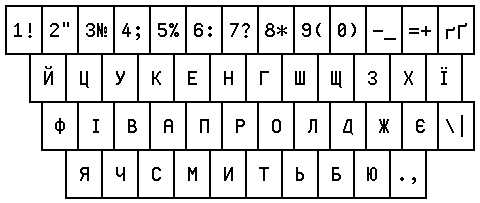 Keyboard Layout
Keyboard Layout -
unicode.mim (language:generic name:unicode icon:
 )
)Input method for Unicode characters using hexadigits. Type C-u followed by hexadecimal numbers [0-9A-Fa-f] of a Unicode character code. To finish and insert the resulting character, type a space. If you type more than 5 hex digits and finish with space, the result is empty and nothing at all is inserted.
-
ur-phonetic.mim (language:ur name:phonetic icon:
 )
)Urdu phonetic keyboard layout for m17n-db Author: Tahir Abdul Rauf Butt <linux_kernel_worm@yahoo.com>
-
uz-kbd (language:uz name:kbd
 )Input method for Uzbek by simulating the Uzbek keyboard.
)Input method for Uzbek by simulating the Uzbek keyboard.
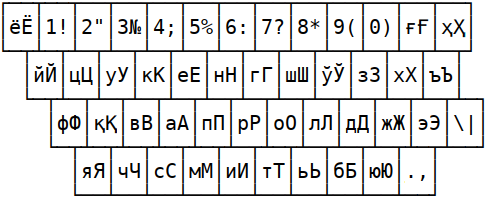 Keyboard Layout
Keyboard Layout -
vi-base.mim (extra-name:nil, only for inclusion)
Provide bases for Vietnamese input methods. This is acutually not a standalone input method, but is expected to be included in the other Vietnamese input method (e.g. vi-telex, vi-vni).
-
vi-han.mim (language:vi name:han icon:
 )
)Han Viet input method with Viet-phonetic sequence, "telex" formal. In addition to Chinese characters, fullwidth latin characters and symbols are available in fullwidth mode (turns on and off by ">>" and "<<" respectively). This mode can also be turned on temporarily by typing "Z".
-
vi-nomtelex.mim (language:vi name:nomtelex icon:
 )
)Chu Nom input method with Viet-phonetic sequence, "telex" formal. In addition to Chinese characters, fullwidth latin characters and symbols are available in fullwidth mode (turns on and off by ">>" and "<<" respectively). This mode can also be turned on temporarily by typing "Z".
-
vi-nomvni.mim (language:vi name:nomvni icon:
 )
)Chu Nom input method with Viet-phonetic sequence, "VNI" formal. In addition to Chinese characters, fullwidth latin characters and symbols are available in fullwidth mode (turns on and off by ">>" and "<<" respectively). This mode can also be turned on temporarily by typing "Z". Tone marks type at the end of words. Circumflex, reverse circumflex and horn mark type just next the vowel.
-
vi-tcvn.mim (language:vi name:tcvn icon:
 )
)Vietnames input method using the TCVN6064 sequence. Typing Backslash ('\') toggles the normal mode and English mode. The following variables are customizable: tone-mark-on-last: control tone mark position in equivocal cases backspace-is-undo: control the action of Backspace key (delete or undo) -
vi-telex.mim (language:vi name:telex icon:
 )
)Vietnames input method using the TELEX key sequence. Typing Backslash ('\') toggles the normal mode and English mode. The following variables are customizable: tone-mark-on-last: control tone mark position in equivocal cases backspace-is-undo: control the action of Backspace key (delete or undo) -
vi-viqr.mim (language:vi name:viqr icon:
 )
)Vietnames input method using the VIQR key sequence. Typing Backslash ('\') toggles the normal mode and English mode. The following variables are customizable: tone-mark-on-last: control tone mark position in equivocal cases backspace-is-undo: control the action of Backspace key (delete or undo) -
vi-vni.mim (language:vi name:vni icon:
 )
)Vietnames input method using the VNI key sequence. Typing Backslash ('\') toggles the normal mode and English mode. The following variables are customizable: tone-mark-on-last: control tone mark position in equivocal cases backspace-is-undo: control the action of Backspace key (delete or undo) -
yi-yivo.mim (language:yi name:yivo icon:
 )
)Yiddish input method using YIVO transliteration. A short description of the YIVO transliteration scheme can be found here: http://www.ibiblio.org/pub/academic/languages/yiddish/mendele/vol4.170 A description of the YIVO orthography can be found in Mordkhe Schaechter, _Der eynheytlekher Yidisher oysleyg: Takones fun yidishn oysleyg_, New York: Yivo and Yiddish Language Resource Center of the League for Yiddish (6th ed. 1999).
-
zh-bopomofo (language:zh name:bopomofo
 )Input method for Bopomofo.
)Input method for Bopomofo.
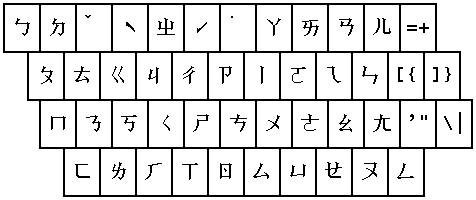 Keyboard Layout
Keyboard Layout -
zh-cangjie.mim (language:zh name:cangjie icon:
 )
)Chinese input method with CANGJIE method. In addition to Chinese characters, fullwidth latin characters and symbols are available in fullwidth mode (turns on and off by ">>" and "<<" respectively). This mode can also be turned on temporarily by typing "Z".
-
zh-pinyin-vi.mim (language:zh name:pinyin-vi icon:
 )
)Input method for Chinese Pinyin characters.Note that it's not for inputting Han characters.
-
zh-pinyin.mim (language:zh name:pinyin icon:
 )
)Input method for Chinese Pinyin characters. Note that it's not for inputting Han characters.
-
zh-py-b5.mim (language:zh name:py-b5 icon:
 )
)Chinese Big5 input method with Pinyin sequence. In addition to Chinese characters, fullwidth latin characters and symbols are available in fullwidth mode (turns on and off by ">>" and "<<" respectively). This mode can also be turned on temporarily by typing "Z".
-
zh-py-gb.mim (language:zh name:py-gb icon:
 )
)Chinese GB2312 input method with Pinyin sequence. In addition to Chinese characters, fullwidth latin characters and symbols are available in fullwidth mode (turns on and off by ">>" and "<<" respectively). This mode can also be turned on temporarily by typing "Z".
-
zh-py.mim (language:zh name:py icon:
 )
)Chinese input method with Pinyin sequence. In addition to Chinese characters, fullwidth latin characters and symbols are available in fullwidth mode (turns on and off by ">>" and "<<" respectively). This mode can also be turned on temporarily by typing "Z".
-
zh-quick.mim (language:zh name:quick icon:
 )
)Chinese input method with QUICK method. In addition to Chinese characters, fullwidth latin characters and symbols are available in fullwidth mode (turns on and off by ">>" and "<<" respectively). This mode can also be turned on temporarily by typing "Z".
-
zh-tonepy-b5.mim (language:zh name:tonepy-b5 icon:
 )
)Chinese Big5 input method with Pinyin+Tone sequence. In addition to Chinese characters, fullwidth latin characters and symbols are available in fullwidth mode (turns on and off by ">>" and "<<" respectively). This mode can also be turned on temporarily by typing "Z".
-
zh-tonepy-gb.mim (language:zh name:tonepy-gb icon:
 )
)Chinese GB2312 input method with Pinyin+Tone sequence. In addition to Chinese characters, fullwidth latin characters and symbols are available in fullwidth mode (turns on and off by ">>" and "<<" respectively). This mode can also be turned on temporarily by typing "Z".
-
zh-tonepy.mim (language:zh name:tonepy icon:
 )
)Chinese input method with Pinyin-and-tone sequence. In addition to Chinese characters, fullwidth latin characters and symbols are available in fullwidth mode (turns on and off by ">>" and "<<" respectively). This mode can also be turned on temporarily by typing "Z".
-
zh-util.mim (extra-name:nil, only for inclusion)
Provide utilities for Chinese input methods. This is acutually not a standalone input method, but is expected to be included in the other Chinese input method (e.g. zh-py).
-
zh-zhuyin (language:zh name:zhuyin
 )Input method for Chinese.
)Input method for Chinese.
 Keyboard Layout
Keyboard Layout
Font Layout Table
See Font Layout Table for the format of these files.
-
ARAB-OTF-NO-GPOS.flt
For Arabic OpenType fonts that don't have GPOS table to draw the Arabic script.
-
ARAB-OTF.flt
For Arabic OpenType fonts to draw the Arabic script.
-
ARAB.flt
For Arabic fonts of Unicode encoding to draw Arabic script.
-
BENG-OTF.flt
For Bengali OpenType fonts to draw the Bengali script.
-
BNG2-OTF.flt
For bng2 OpenType fonts to draw the Bengali script.
-
CHAM-GENERIC.flt
For the Cham proportional fonts to draw Cham script.
-
COMBINING.flt
For combining diacritical marsk (U+0300..U+036F).
-
DEV2-OTF.flt
For dev2 OpenType fonts to draw the Devanagari script.
-
DEVA-CDAC.flt For the font DVYG0ntt.ttf (developed by C-DAC, encoding is ISFOC) to draw Devanagari script.
-
DEVA-OTF.flt
For Devanagari OpenType fonts to draw the Devanagari script.
-
GJR2-OTF.flt
For gjr2 OpenType fonts to draw the Gujarati script.
-
GUJR-OTF.flt
For Gujarati OpenType fonts to draw the Gujarati script.
-
GUR2-OTF.flt
For gur2 OpenType fonts to draw the Gurmukhi script.
-
GURU-OTF.flt
For Gurmukhi OpenType fonts to draw the Gurmukhi script.
-
HEBR-FF.flt
For Hebrew fonts of Unicode encoding to draw the Hebrew script. This is for such fonts that do not require an explicit combining code because accents and points have negative lbearing.
-
HEBR-OTF.flt
For Hebrew OpenType fonts to draw the Hebrew script.
-
HEBR.flt
For Hebrew fonts of Unicode encoding to draw Hebrew script. This is for such a font that requires explicit combining code to draw accents and points.
-
KHMR-ANLONG.flt
For the font ANLONG.TTF to draw Khmer script. The font is available at:
-
KHMR-OTF.flt
For Khmer OpenType fonts to draw Khmer. A Font is available from https://sourceforge.net/projects/khmer/files/Fonts%20-%20KhmerOS/KhmerOS%20Fonts%204.0-%20LGPL%20License/.
-
KND2-OTF.flt
For knd2 OpenType fonts to draw the Kannada script.
-
KNDA-OTF.flt
For Kannada OpenType fonts to draw the Kannada script.
-
LAOO-ALICE.flt
For the font ALICE0.TTF to draw Lao script. The font is available at:
-
LAOO-GENERIC.flt
-
LAOO-MULE.flt
For Lao fonts of mule encoding to draw Lao script. The font is available at:
-
LAOO-OTF.flt
-
MLM2-OTF.flt
For mlm2 OpenType fonts to draw the Malayalam script.
-
MLYM-CDAC.flt
-
MLYM-OTF.flt
For Malayalam OpenType fonts to draw the reformed Malayalam script.
-
MLYM-RACHANA.flt
For the Rachana Malayalam fonts to draw the traditional Malayalam script. This fonts handles virtually all ligatures with the AKHN feature without character reordering.
-
MYMR-MYAZEDI.flt
For the Myanmar Zedi family fonts to draw Myanmar script.
-
MYMR-SIL.flt
For Padauk.ttf to draw the Myanmar script.
-
NO-CTL.flt
This is to suppress Complex Text Layout for many scripts. This FLT can be used for fonts that have Unicode encoding. Even if a glyph in a font has zero width, the glyph is displayed as if it is a spacing glyph.
-
ORY2-OTF.flt
For ory2 OpenType fonts to draw the Oriya script.
-
ORYA-OTF.flt
For Oriya OpenType fonts to draw the Oriya script.
-
SINH-OTF.flt
For Sinhala OpenType fonts to draw Sinhala. A Font is available from http://sinhala.sourceforge.net/files/.
-
SYRC-OTF.flt
For Syriac OpenType fonts to draw the Syriac script.
-
TAML-CDAC.flt
-
TAML-OTF.flt
For Tamil OpenType fonts to draw the Tamil script.
-
TEL2-OTF.flt
For tel2 OpenType fonts to draw the Telugu script.
-
TELU-OTF.flt
For Telugu OpenType fonts to draw the Telugu script.
-
THAA-OTF.flt
For Thaana OpenType fonts to draw the Thaana script.
-
THAI-GENERIC.flt
For the Thai proportional fonts to draw Thai script.
-
THAI-NORASI.flt
For the Thai Norasi family fonts to draw Thai script. The fonts are available at:
- debian package: ttf-thai-tlwg
-
THAI-OTF.flt
-
THAI-TIS620.flt
For fixed width fonts of TIS620 encoding to draw Thai script.
-
TIBT-MTIB.flt
For the Tibetan TrueType font developed by Dr. Tomabechi to draw Tibetan script. The font is available at:
-
TIBT-MULE.flt
For the muletibetan font developed by Dr. Tomabechi to draw Tibetan script. The font is available at:
-
TIBT-OTF.flt
For TibetanMachineUniAlpha.ttf to draw Tibetan script. The font is available at:
- debian package: ttf-tmuni
-
TML2-OTF.flt
For tml2 OpenType fonts to draw the Tamil script.
Fontset
See Fontset for the format of these files.
-
default.fst
The default fontset. It is the union of generic.fst and xfont.fst.
-
xfont.fst
Fontset using only X fonts.
-
truetype.fst
Fontset using only freely available TrueType fonts.
-
DejaVuSans.ttf (family: DejaVu Sans)
- debian package: ttf-dejavu-core
-
SILEOT.ttf (family: ezra sil; for Hebrew)
- debian package: ttf-sil-ezra
-
ScheherazadeRegOT.ttf (family: scheherazade; for Arabic)
- debian package: ttf-sil-scheherazade
- SyrCOMTalada.otf (family: estrangelo talada; for Syriac)
- SyrCOMJerusalem.otf (family: serto jerusalem; for Syriac)
-
SyrCOMAdiabene.otf (family: east syriac adiabene; for Syriac)
- debian package: ttf-xfree86-nonfree-syriac
- mvboli.ttf (family: mv boli; for Thaana)
- gargi.ttf (family: gargi; for Devanagari)
-
lohit_hi.ttf (family: lohit hindi; for Devanagari)
- debian package: ttf-devanagari-fonts
- lohit_bn.ttf (family: lohit bengali; for Bengali)
-
MuktiNarrow.ttf (family: mukti narrow; for Bengali)
- debian package: ttf-bengali-fonts
- lohit_pa.ttf (family: lohit punjabi; for Gurmukhi)
-
Saab.ttf (family: saab; for Gurmukhi)
- debian package: ttf-punjabi-fonts
- lohit_gu.ttf (family: lohit gujarati; for Gujarati)
-
Rekha.ttf (family: rekha; for Gujarati)
- debian package: ttf-gujarati-fonts
-
utkal.ttf (family: utkal; for Oriya)
- debian package: ttf-oriya-fonts
-
lohit_ta.ttf (family: lohit tamil; for Tamil)
- debian package: ttf-tamil-fonts
- Pothana2000.ttf (family: pothana2000; for Telugu)
-
Vemana.ttf (family: vemana2000; for Telugu)
- debian package: ttf-telugu-fonts
- Kedage-n.ttf (family: kedage; for Kannada)
-
Malige-n.ttf (family: mallige; for Kannada)
- debian package: ttf-kannada-fonts
- Meera_04.ttf (family: meera; for Malayalam)
-
Rachana_04.ttf (family: rachana; for Malayalam)
- debian package: ttf-malayalam-fonts
-
lklug.ttf (family: lklug; for Sinhala)
- debian package: ttf-sinhala-lklug
-
TibetanMachineUniAlpha.ttf (family: tibetan machine uni; for Tibetan)
- debian package: ttf-tmuni
-
Norasi.ttf (family: norasi; for Thai)
- debian package: ttf-thai-tlwg
-
Phetsarath_OT.ttf (family: phetsarath ot; for Lao)
- debian package: ttf-lao
-
Padauk.ttf (family: padauk; for Myanmar)
- debian package: ttf-sil-padauk
-
KhmerOS.ttf (family: khmer os; for Khmer)
- debian package: ttf-khmeros
-
wqy-zenhei.ttf (family: wenquanyi zen hei; for Chinese)
- debian package: ttf-wqy-zenhei
-
TakaoGothic.ttf (family: takaogothic)
- debian package: ttf-takao-gothic
-
UnDotum.ttf (family: undotum; for Korean)
- debian package: ttf-unfonts-core
-
Abyssinica_SIL.ttf (family: abyssinica sil; for Ethiopic)
- debian package: ttf-sil-abyssinica
-
DejaVuSans.ttf (family: DejaVu Sans)
-
generic.fst
Fontset mainly using generic font specifications. See the documentation of the fontset "default" for the information about each font.
The other data
-
FONTENC.tbl
Information about encodings of fonts. See the section Font Encoding.
-
FONTSIZE.tbl
Information about how much to resize fonts. See the section Font Size.
-
CHARSET.tbl
List of charset definitions. See the section List of character set definitions for the format of this file.
-
CODING.tbl
List of coding system definitions. See the section List of coding system definitions for the format of this file.
-
SCRIPT-OTF.tbl
Table of scripts vs the corresponding OTF script tags.
-
SCRIPT-LANGUAGE.tbl
Table of scripts vs languages using the corresponding script.
-
SCRIPT-LANGUAGE.tbl
Table of scripts vs languages using the corresponding script.
